One Perfect Day in Siena, Italy: 15 Best Things to Do, See, and Skip

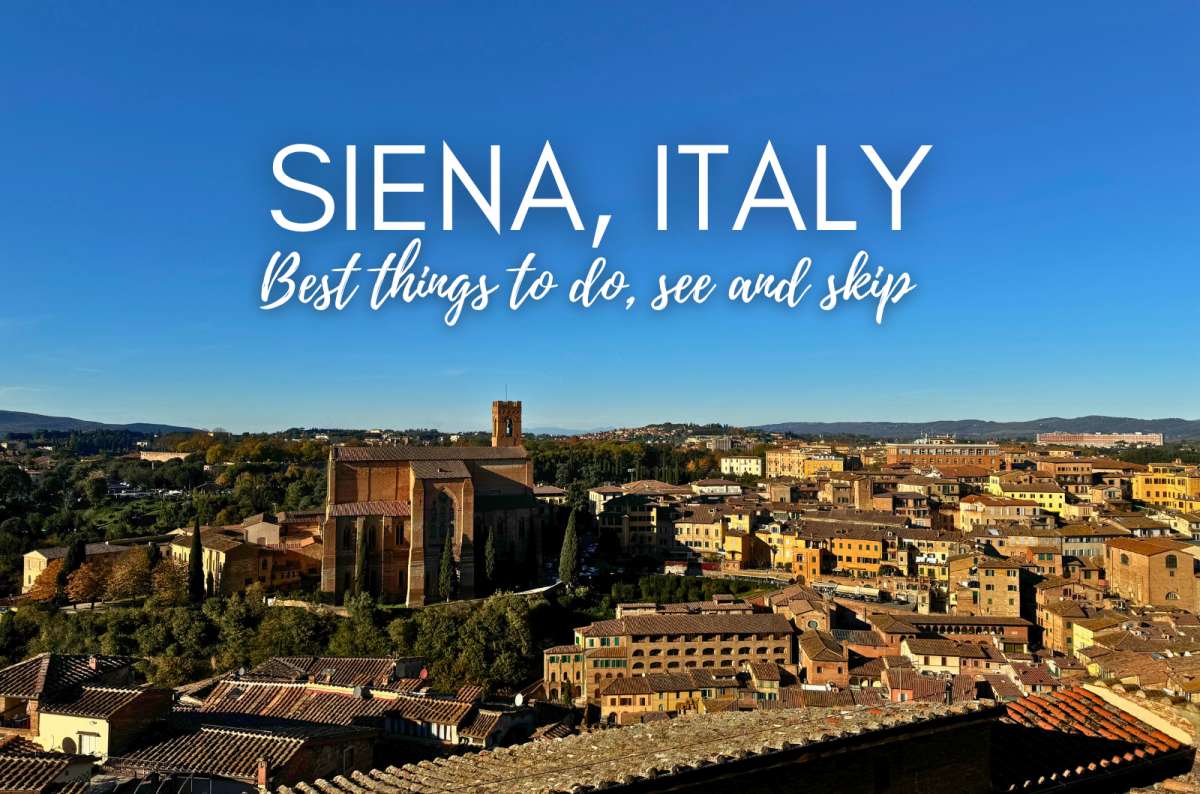
What you’ll find in this article
Map of what to see in Siena, Italy
Quick list: 15 best places to visit and what to do in Siena in a day
1. The Siena Cathedral Complex and Piazza del Duomo: 2–3 hours total
2. Facciatone Panorama (enter through cathedral museum): 30-minute visit
3. Museo dell’Opera (part of cathedral combo): 30-minute visit
4. Crypt (inside the cathedral): 10-minute visit
5. Baptistery of San Giovanni (inside the cathedral): 15-minute visit
6. Picolomini Library (inside the cathedral): 5-minute visit
7. Porta del Cielo aka “Gate of Heaven” (inside the cathedral): 25-minute visit
8. Siena’s main square, Piazza del Campo, and Palazzo Publico, the town hall: 15-minute visit
9. Fortezza Medicea (fortress viewpoint): 30-minute visit
10. Basilica Cateriniana San Domenico—the one with a saint’s head: 15-minute visit
11. Sanctuary of Saint Catherine of Siena (Santuario Casa di Santa Caterina): 15-minute visit
12. Fontanina Contrada dell’Oca / Fontebranda: 15-minute visit
13. Musei dell’Accademia dei Fisiocritici—Siena’s natural history museum: 45–60 min+
14. National Picture Gallery of Siena: 45-minute visit
15. Bonus stop near Siena: San Gimignano, the tower town (2–3 hours)
One day in Siena itinerary: Step by step
Visiting in summer? Experience Siena’s famous event: The Palio di Siena
Planning a Siena day trip from Florence? I was too, so I visited Siena Italy myself and I’m happy to report that it’s an unmissable spot on your Tuscany itinerary. It’s compact, dramatically medieval, and it oozes piety—as an atheist, I worried lightning was going to strike any moment. You know, as a warning. From God.
A one-day itinerary in Siena is the perfect amount of time to see all the highlights. When I went, I also managed to squeeze in San Gimignano into the same trip—an ok place to stop en route from Florence. Spoiler: Unlike Siena, it’s way overyhyped.
Between the endless churches, red brick buildings, towers, and saints, you get the sense that Siena never really left the 14th century. I absolutely adored exploring it—especially the must-visit Siena Cathedral, the views of the Old Town from the fortress, and what some call the most beautiful Italian city square (I don’t agree).
Read more about visiting Italy.
Sometimes, all you need to do is take the first step... I've filtered out the best hotels in Siena for you
Save it for yourself to come back to later, or share with your friends on social media!
What you’ll find in this article
This is my guide to the unmissable things to do in Siena in one day, with my smart travel tips and what I really thought about each place, visitor information, and my itinerary notes where I show you how to put it all together. Using it, you’ll be able to plan your own perfect Siena day trip.
Hotel tip: Staying the night in Siena? If you don’t have it in you to travel back to Florence, I strongly recommend Hotel Certosa Di Maggiano. It’s a former monastery and oh so peaceful.
Map of what to see in Siena, Italy
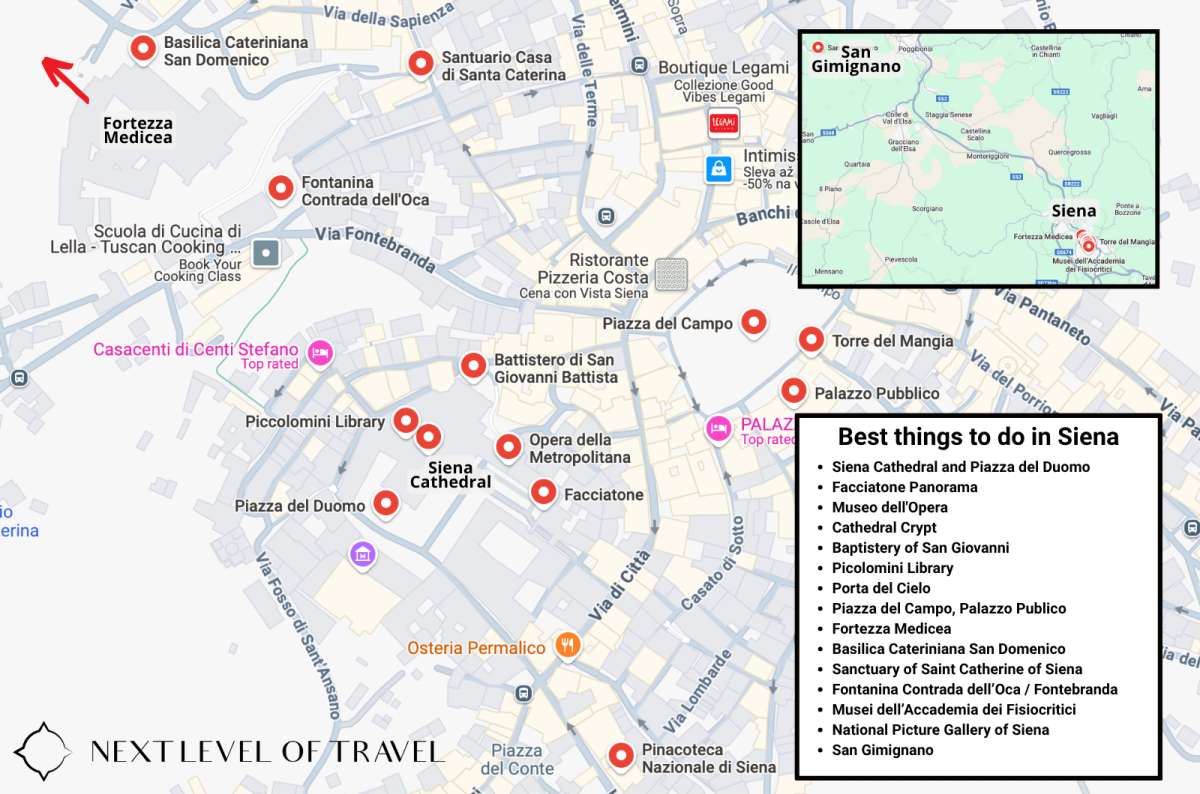
Map of places to visit in Siena, Italy
Quick list: 15 best places to visit and what to do in Siena in a day
- Siena Cathedral and Piazza del Duomo—Gothic cathedral with striped marble, and impressive square
- Facciatone Panorama—Rooftop viewpoint from the unfinished cathedral façade
- Museo dell'Opera—Museum of cathedral relics
- Cathedral Crypt—Small space under the Duomo with 13th-century frescoes
- Baptistery of San Giovanni—Underground baptistery with bronze panels
- Picolomini Library—Ornate room with illuminated choir books
- Porta del Cielo—Guided rooftop walk through the cathedral’s upper galleries
- Piazza del Campo, Palazzo Pubblico—Main square with unique shape and medieval tower
- Fortezza Medicea—Public park and fortress with panoramic views of the city
- Basilica Cateriniana San Domenico—Large basilica holding relics of Saint Catherine
- Sanctuary of Saint Catherine of Siena—Her family home, now a peaceful religious site
- Fontanina Contrada dell’Oca/Fontebranda—Medieval fountain fed by ancient aqueduct
- Musei dell’Accademia dei Fisiocritici—Natural history museum
- National Picture Gallery of Siena—Major collection of Sienese School paintings
- San Gimignano—Hilltop town near Siena known for medieval towers and scenic views

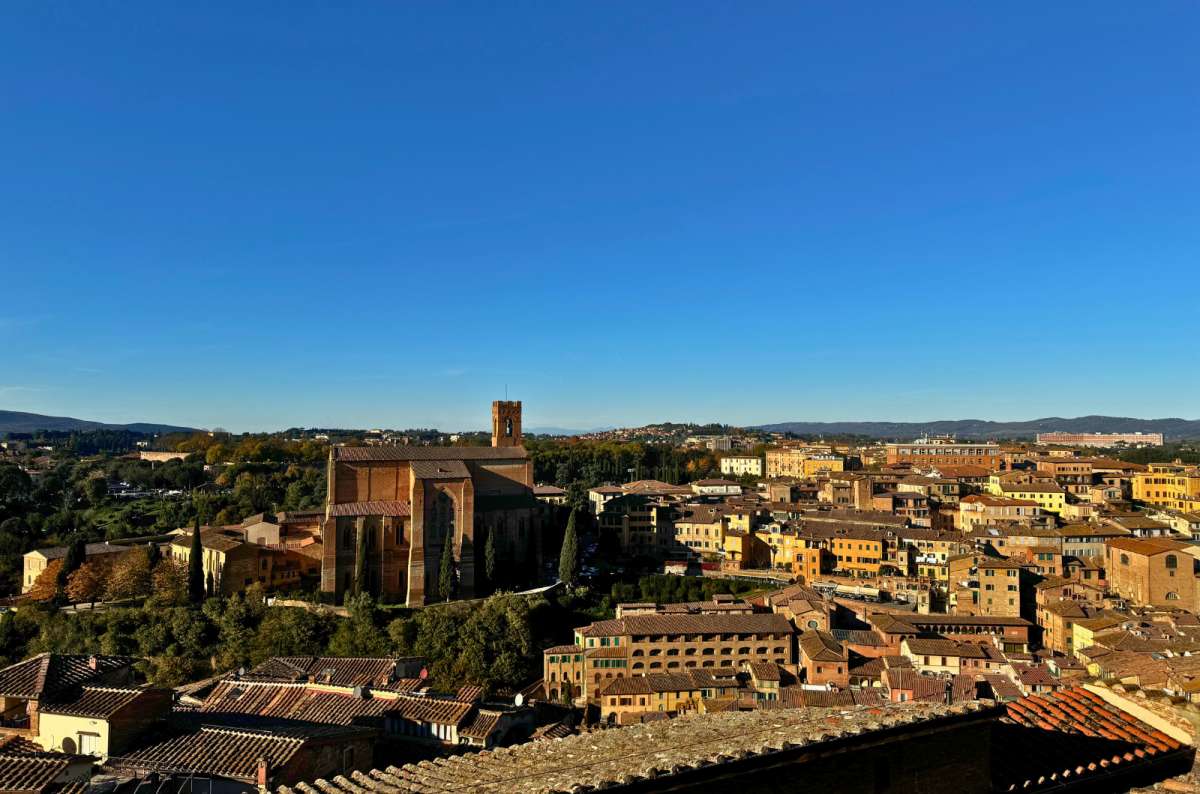
Siena will definitely charm you with its medieval vibes, religious themes and supreme architecture
Here’s everything you need to see in Siena if you’re visiting on a day trip, in detail:
1. The Siena Cathedral Complex and Piazza del Duomo: 2–3 hours total
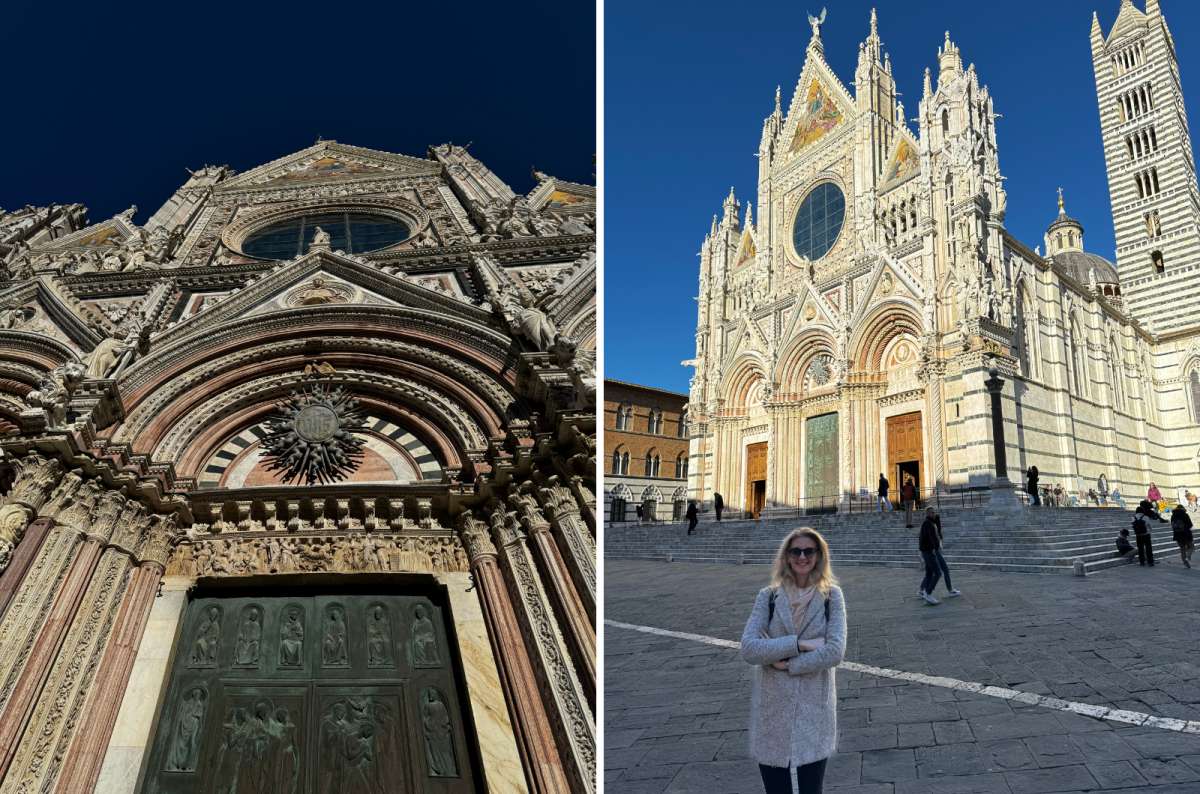
The Siena Cathedral is a place like no other
Visitor information:
- Price: EUR 21 for combo ticket (buy the Opa SI Pass online in advance to skip the line)
- Opening hours:
- March 1–November 3, 2024: 10 am–7pm
- November 4–December 24, 2024: 10:30 am–5:30 pm
- December 26, 2024–January 7, 2025: 10 am–7pm
If you do just one thing in Siena, make it the Duomo complex. Get the full Duomo combo ticket for EUR 21—it’s not a tourist scam. You get the Cathedral, Picolomini Library, Baptistery, Crypt, Cathedral Museum, Facciatone Panorama, and Porta del Cielo (Gate of Heaven). It’s massive, and shockingly good value.
Everything is right there on Piazza del Duomo, which feels more like a museum courtyard than a city square. It’s quieter than Siena’s main piazza, but the cathedral literally speaks volumes even on its own.
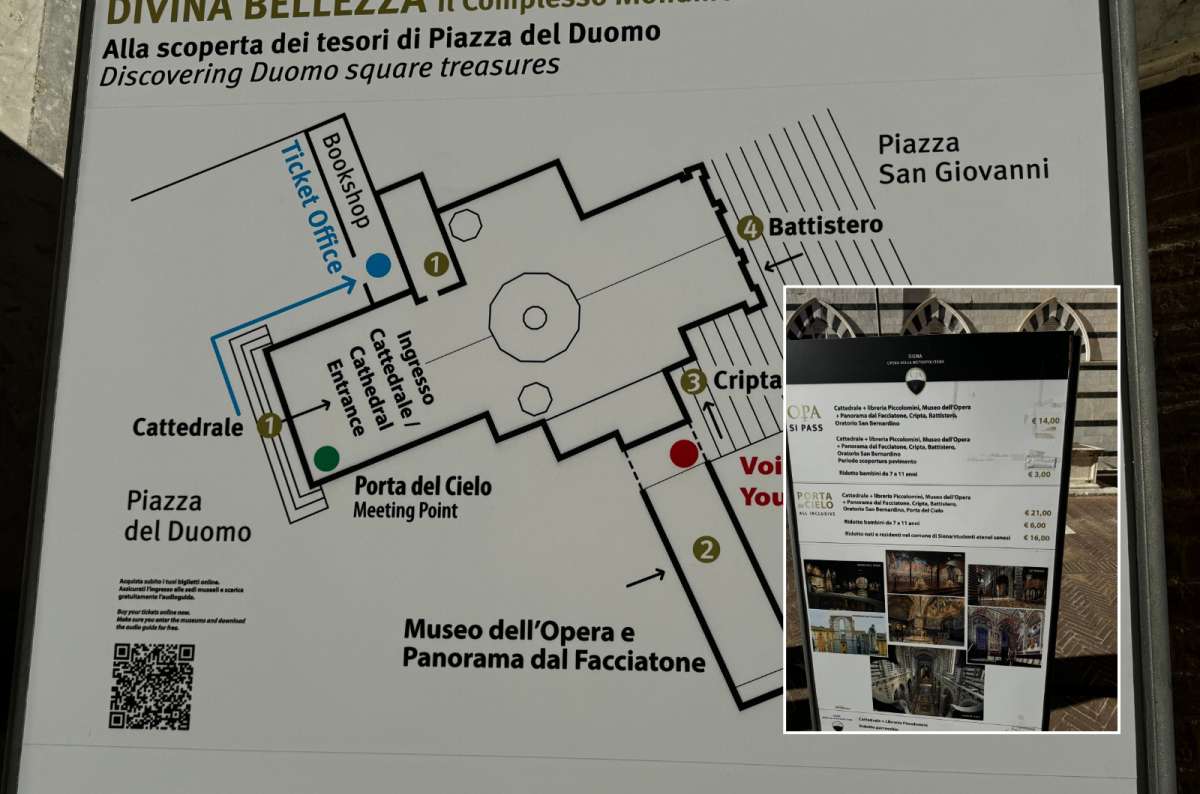
The guide to the “museum courtyard” is rather simple @ Piazza del Duomo
The Cathedral (Duomo di Siena) has easily one of Italy’s most spectacular interiors. If you’ve read my Lucca guide (also a solid day trip from Florence, by the way), you’ll remember I said every church there looks better on the outside than inside. Not in Siena.
Not only is the façade unbelievable, but then you walk inside and your jaw will drop. I loved the black-and-white marble stripes—what a statement! I literally said “wow!” out loud the moment I stepped in—well, something slightly less appropriate, but same energy.
Make sure to notice the biblical scenes carved into the floor, also the sacristy and the oratory—intimate, ornate, very nice.
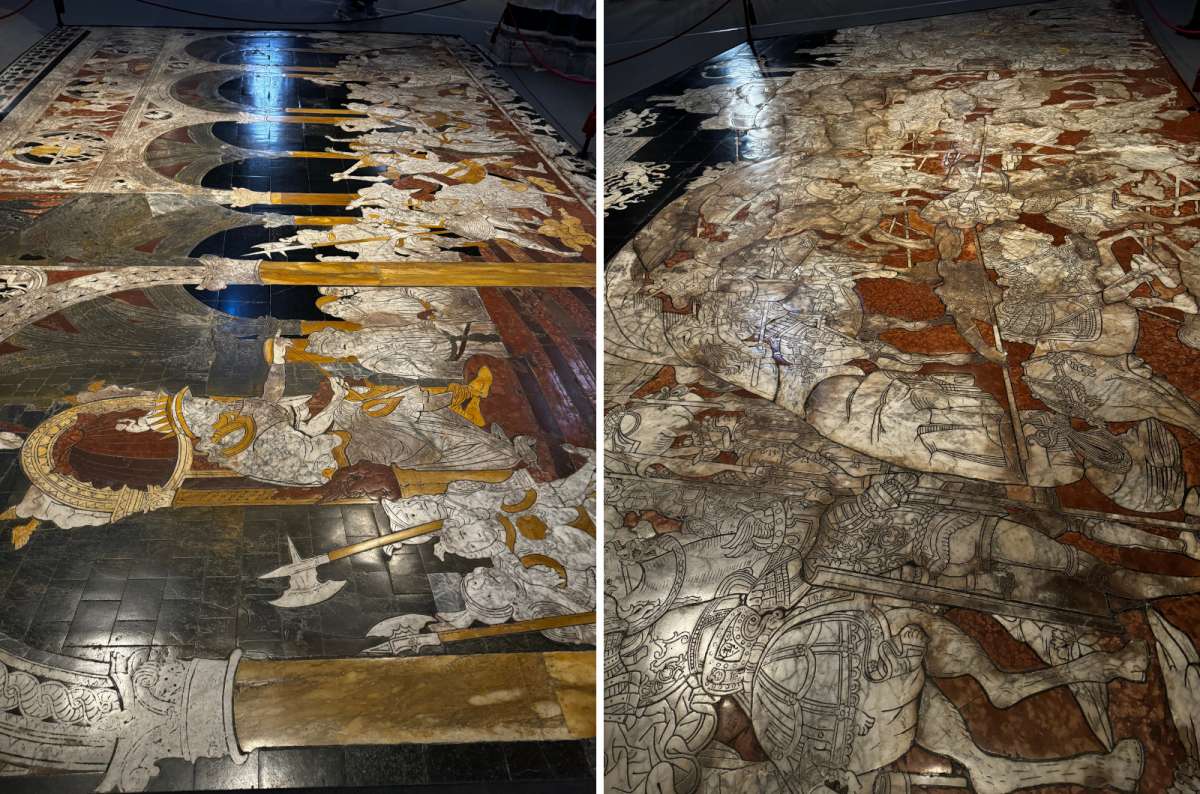
The carvings on the Siena Cathedral floors are a very respectable work of art
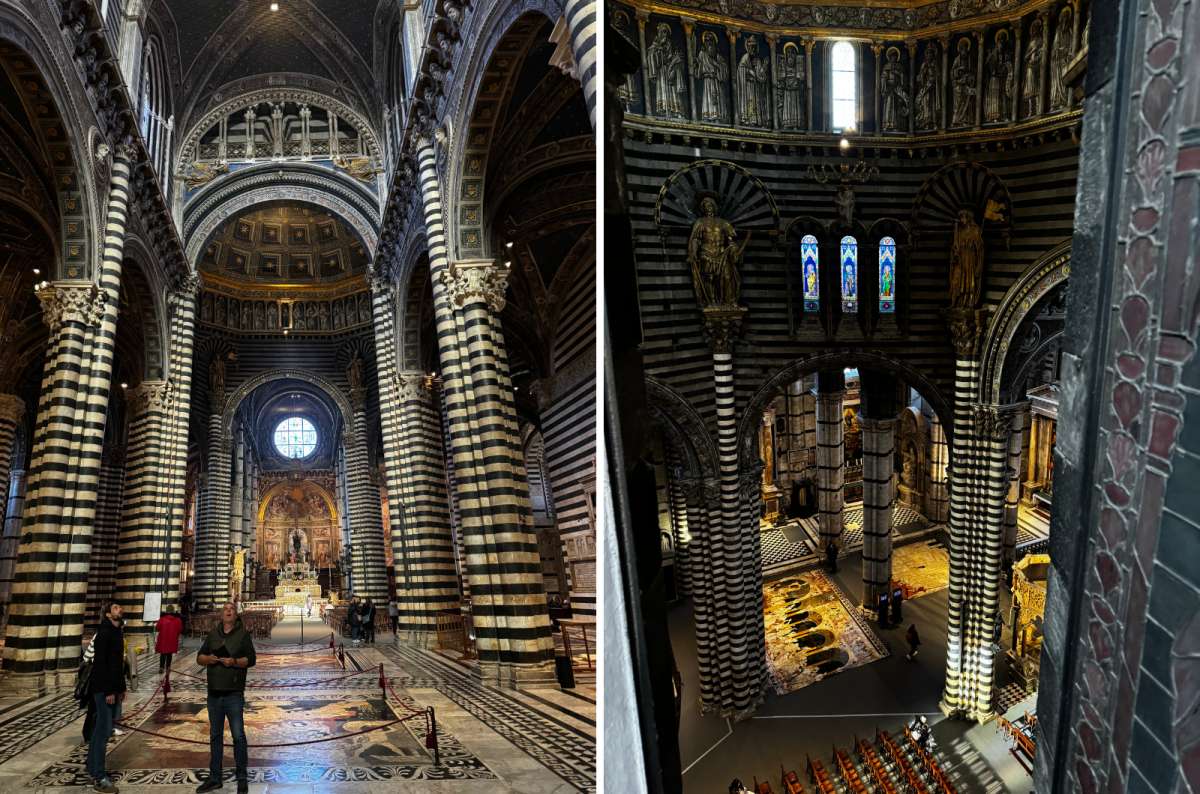
The stripes, ornaments and aura make the Siena Duomo one of the most beautiful cathedrals in Italy
I’ll mention each of the places you can visit inside the Siena Duomo as separate places on this list. They deserve it:
2. Facciatone Panorama (enter through cathedral museum): 30-minute visit

They had these types of scyscrapers back in the day @ Facciatone Panorama
Visitor information:
- Price: EUR 21 (buy the combo ticket aka Opa SI Pass online in advance to skip the line)
- Opening hours:
- Until 31 March: 10:30 am–5:30 pm
- 1 April–31 October: 09:30 am–7:30 pm
Tip: When you visit Siena Cathedral, start at the Facciatone Panorama (Panorama dal Facciatone) and then work your way down and through the other rooms of the cathedral.
This epic viewpoint sits atop the Facciatone—aka the Unfinished Façade of what was supposed to be Siena’s new, even bigger cathedral. Construction started in the 14th century, then the Black Death rolled in and they never finished it. What’s left is a massive wall you can now climb for one of the best views in Siena.
The Facciatone’s entrance is through the museum. You climb up a one-way spiral staircase to two separate levels of the unfinished façade. They limit the number of people going in at one time and you will be told a time limit so the people behind you don’t end up waiting for eternity. It was something like 15 minutes per group when I went, which was more than enough for me.
Pro tip: Budget time to wait in line to enter the Facciatone. Since they let in small groups of people, your 15-minute visit could extend considerably depending on how many visitors are waiting in front of you.
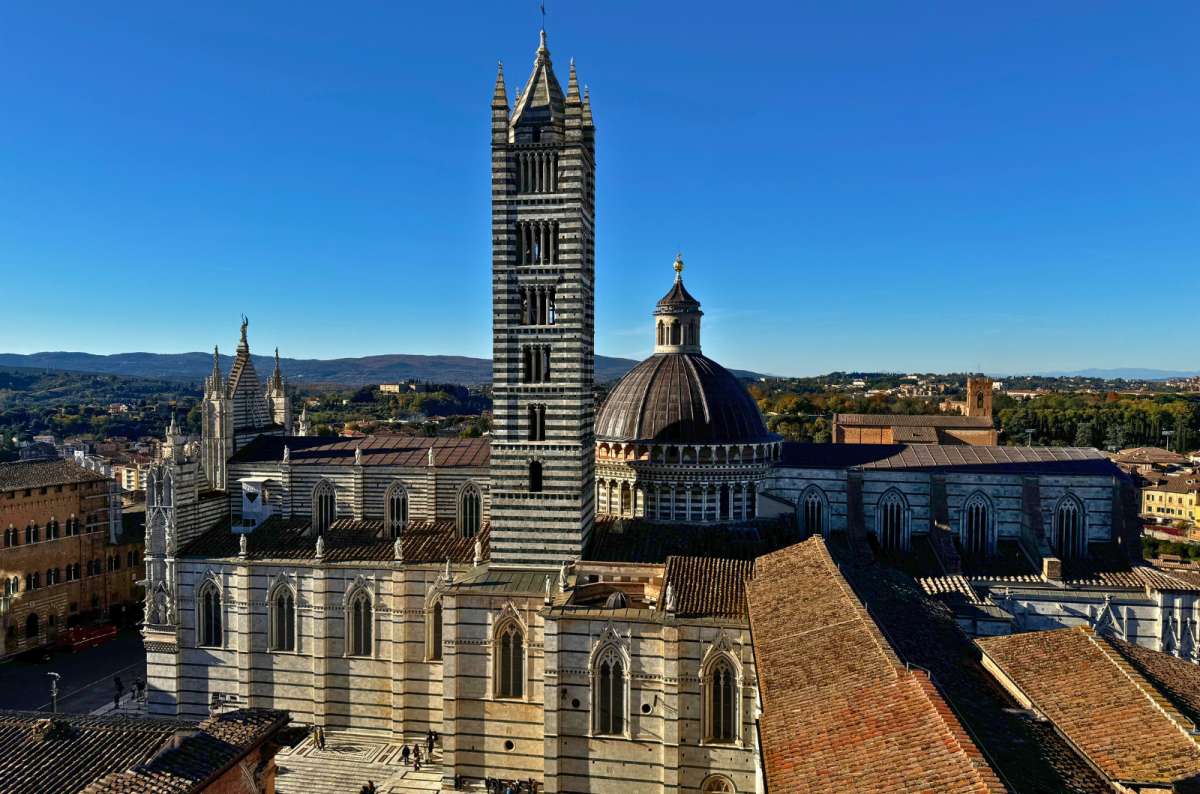
Breathtaking views of the Cathedral @ Facciatone Panorama
Expect epic Siena city views, including the cathedral from above. And in the other direction I noticed just how many churches there are in Siena! The view is great, especially with Tuscany’s rolling hills in the background.
Note the stairs are steep and the railings on the terraces are terrifyingly low.

3. Museo dell’Opera (part of cathedral combo): 30-minute visit
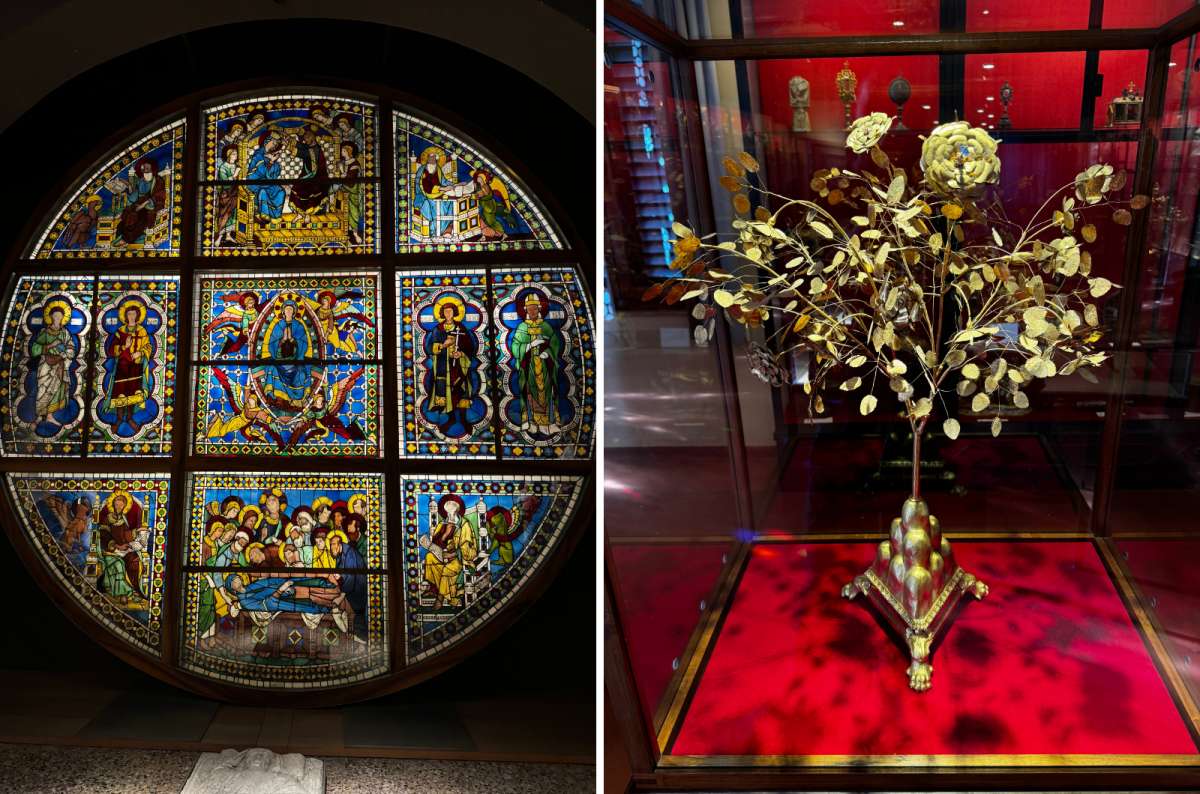
Here you can see the aforementioned golden rose @ Museo dell’Opera
Visitor information:
- Price: EUR 21 (buy the combo ticket aka Opa SI Pass online in advance to skip the line)
- Opening hours:
- 26 December–7 January 2025: 10 am–7 pm
- 8 January–30 March 2025: 10:30 am–5:30 pm
- 31 March–2nd November 2025: 10 am–7 pm
- 3 November–24 December 2025: 10:30 am–5:30 pm
Meh. Standard religious museum stuff like you can find everywhere else in Italy, more or less interesting. Lots of sculptures, relics, and information about the cathedral’s history. Go to the top floors for the more special artifacts. My favorite was a golden rose, sitting pretty in a glass display case.
I found no logic in how the museum is organized. It’s not that it’s bad, it’s just after seeing a few of these museums and churches in Italy, they all start looking the same. If you're doing a Siena day trip from Florence, it’s a solid stop. If you’re in a time crunch and not very religious, you can probably skip it.
4. Crypt (inside the cathedral): 10-minute visit
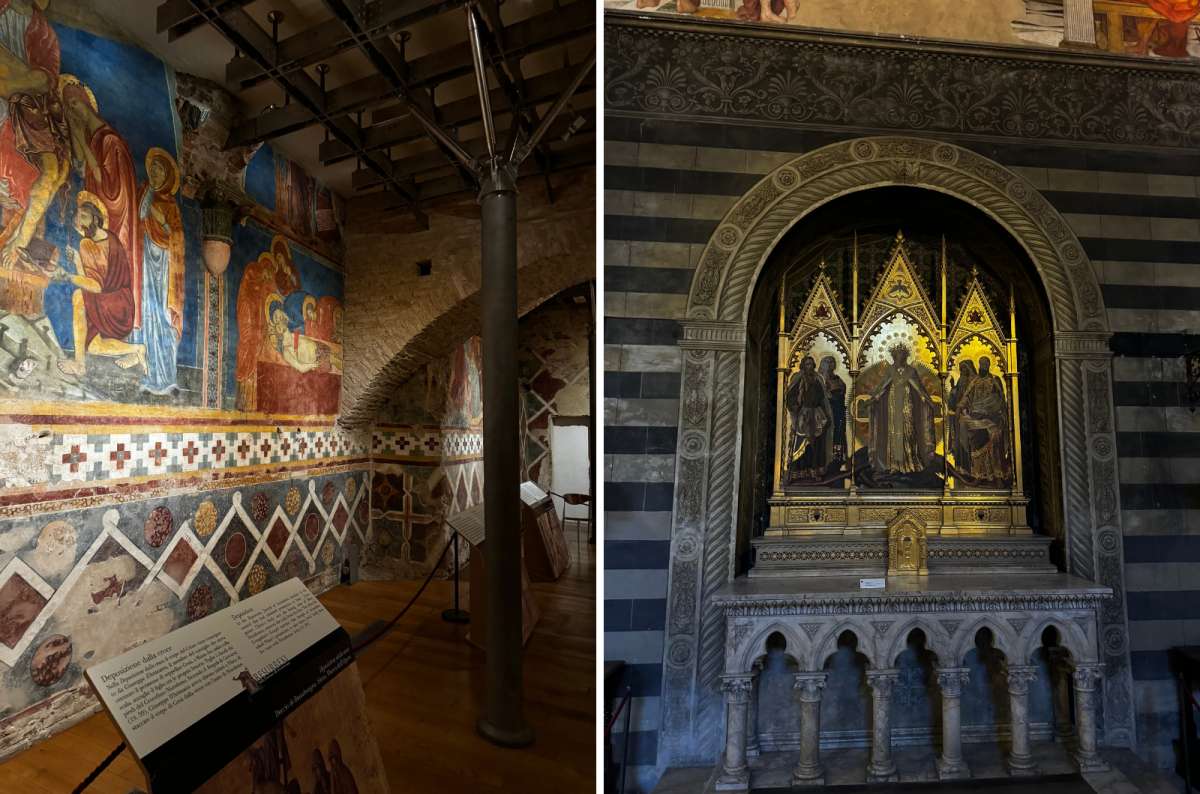
The Crypt shows you a beautiful story through beautiful art that has survived centuries
Visitor information:
- Price: EUR 21 (buy the combo ticket aka Opa SI Pass online in advance to skip the line)
- Opening hours:
- 26 December–7 January 2025: 10 am–7 pm
- 8 January–30 March 2025: 10:30 am–5:30 pm
- 31 March–2nd November 2025: 10 am–7 pm
- 3 November–24 December 2025: 10:30 am–5:30 pm
The crypt (cripta) is a small but impactful thing to see in Siena. There are frescoes that somehow survived 700 years buried under rubble. They basically depict the journey of Jesus to Golgotha, the crucifixion, and the resurrection.
You’ll find the entrance through the back of the cathedral close to the Baptistery.
5. Baptistery of San Giovanni (inside the cathedral): 15-minute visit
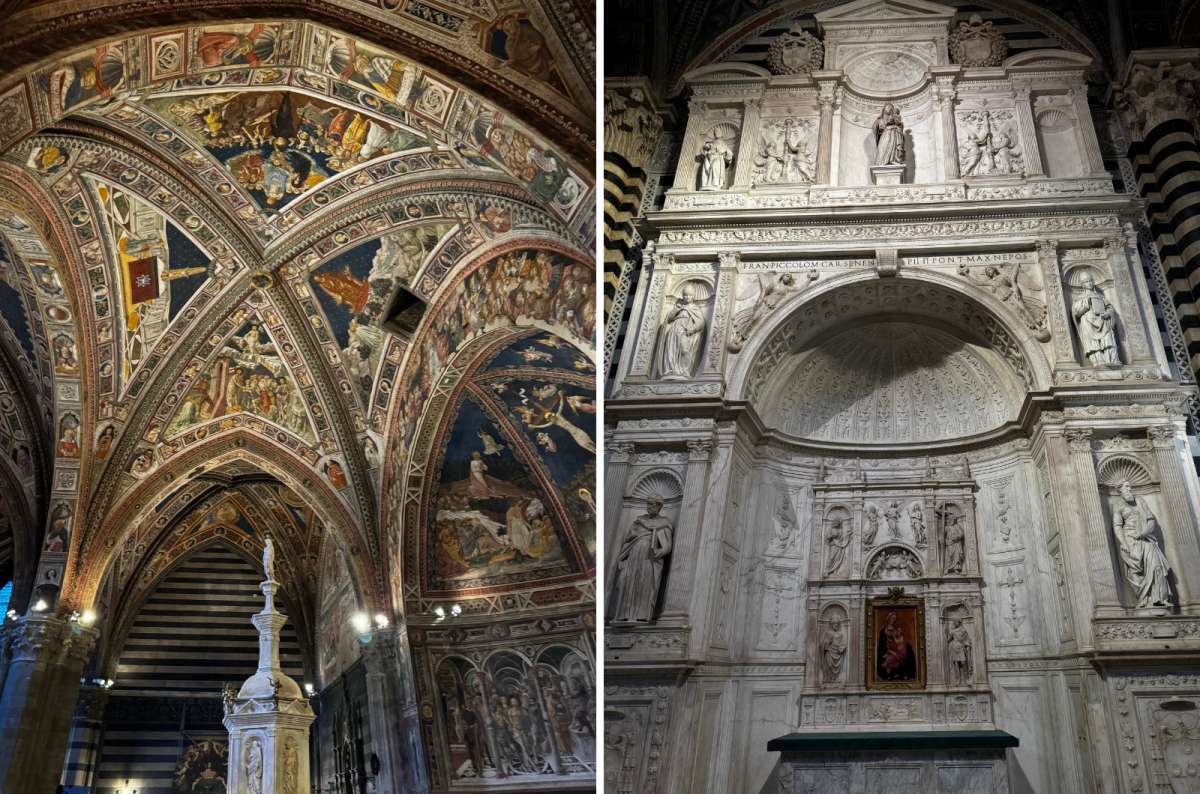
The Baptistery of San Giovanni tries to prove that there is no such thing as “too much”
Visitor information:
- Price: EUR 21 (buy the combo ticket aka Opa SI Pass online in advance to skip the line)
- Opening hours:
- 26 December–7 January 2025: 10 am–7 pm
- 8 January–30 March 2025: 10:30 am–5.30 pm
- 31 March–2nd November 2025: 10 am–7 pm
- 3 November–24 December 2025: 10:30 am–5:30 pm
The Baptistery (Battistero) is one of the more underrated things to do in Siena. It’s not a standalone tower like in Florence—instead, you descend into a magnificent underground vaulted chamber. Even so, the baptistery has a totally brutal façade that makes it clear the instructions when building it were: spare no cost.
Inside, the “more is more” aesthetic continues with fantastic, frescoed ceilings, arches, and a massive hexagonal marble baptismal font with bronze reliefs from Donatello. Every square inch left unfrescoed is adorned by the black and white stripes that make the Duomo so cool.
6. Picolomini Library (inside the cathedral): 5-minute visit
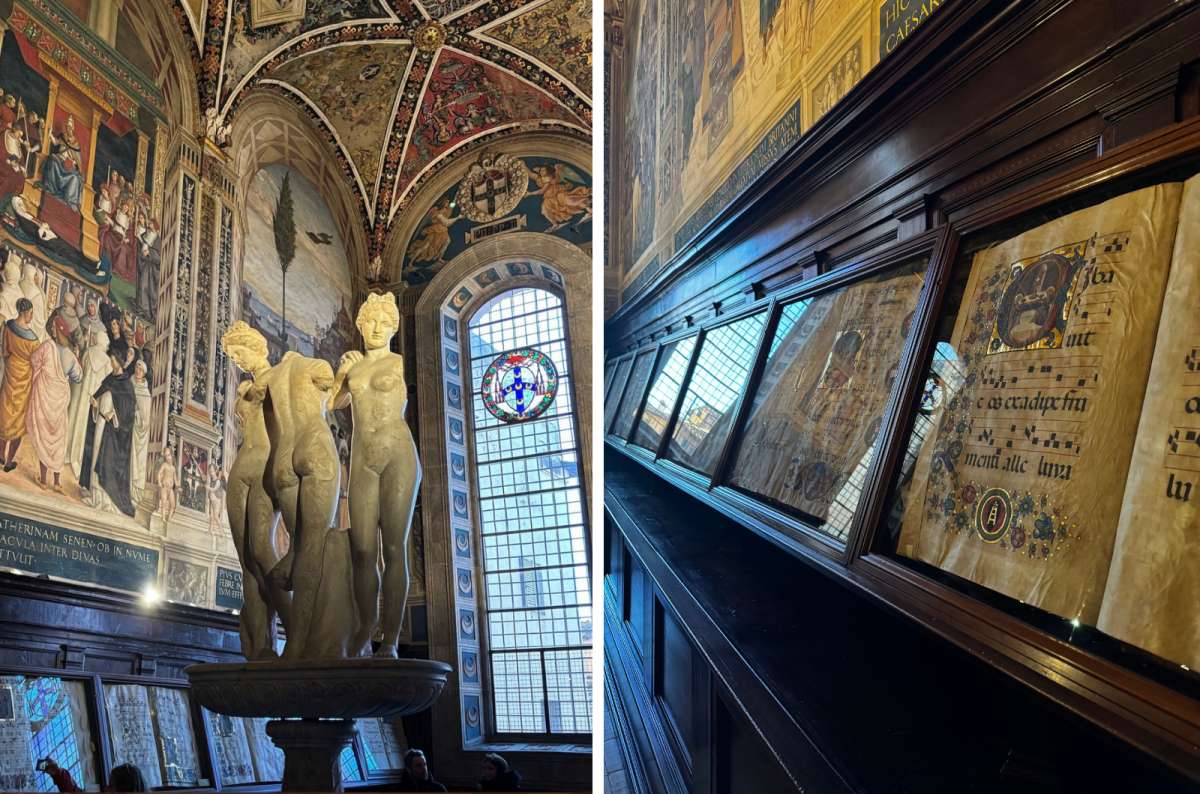
The Picolomini Library is a quick stop, but the books really are nice
Visitor information:
- Price: EUR 21 (buy the combo ticket aka Opa SI Pass online in advance to skip the line)
- Opening hours:
- 26 December–7 January 2025: 10 am–7 pm
- 8 January–30 March 2025: 10:30 am–5:30 pm
- 31 March–2nd November 2025: 10 am–7 pm
- 3 November–24 December 2025: 10:30 am–5:30 pm
The Picolomini Library is just a 5-minute stop, but there’s no reason not to see it since it’s already on your ticket anyway. More frescoes, more medieval bling, but this time with books.
Fun fact: The Libreria Picolomini sounds like it’s name means it’s a tiny library—but no, it’s named after Pope Pius II (real name: Enea Silvio Piccolomini), not its size. Though, to be frank, it is just a smallish room.
The frescoes on the library walls tell the life story of Pope Pius II, and there are a few ancient choir books that belonged to the Pope on display lining the walls.
7. Porta del Cielo aka “Gate of Heaven” (inside the cathedral): 25-minute visit
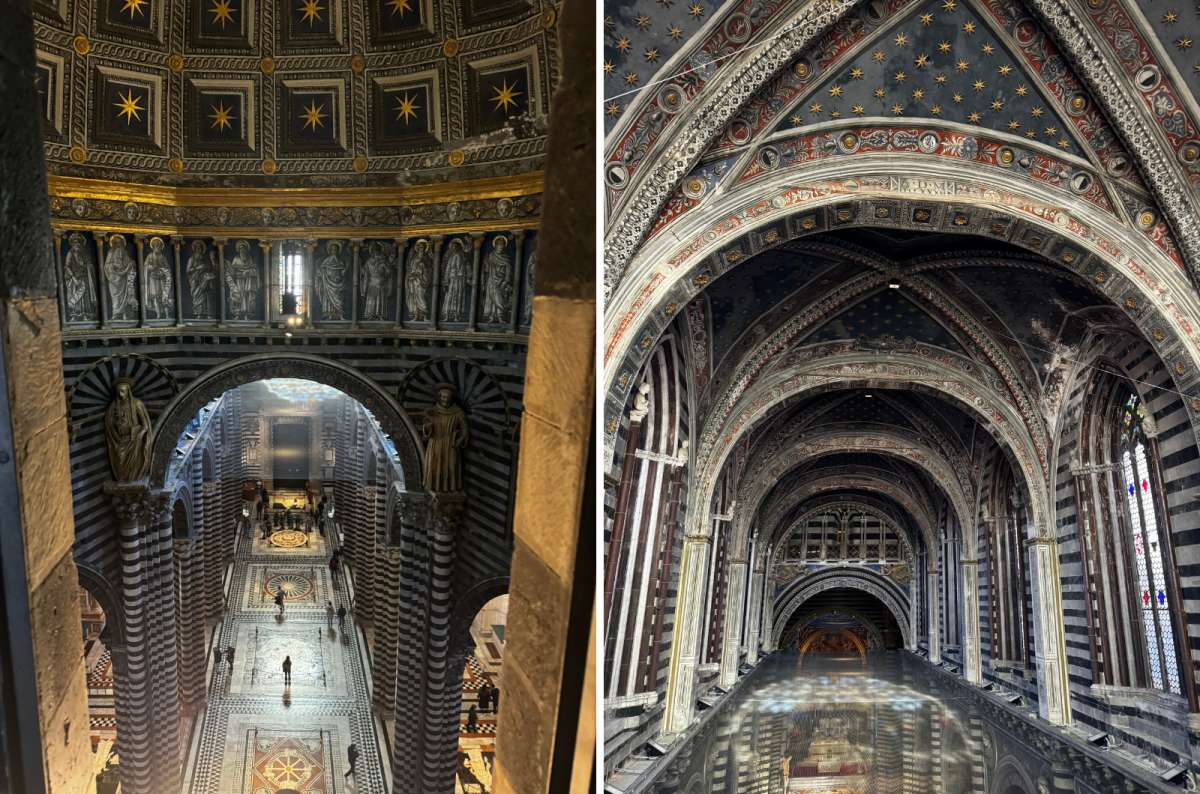
The marble stripes and beautiful floors combined with the stars up on the ceiling make you understand why they call it the Gate of Heaven
Visitor information:
- Price: EUR 21 (buy the combo ticket aka Opa SI Pass online in advance to skip the line)
- Opening hours:
- 1 March–2 November 2025: 10 am–7pm
- 3 November–24 December 2025: 10:30 am–5:30 pm
- 26 December–6 January: 10 am–7 pm
The Gate of Heaven tour is a guided walk through the hidden upper galleries of the cathedral. It’s equal parts cool and slightly annoying. Let me explain.
The Porta del Cielo takes you behind the scenes, through narrow staircases, stone corridors, and interior walkways just below the cathedral’s vaulted ceiling, as well as some outdoor parts where you’re essentially on the rooftop.
My verdict: I thought the EUR 7 extra you pay to have the Porta del Cielo included in your combo ticket is a borderline rip-off, but if money’s no object, go for it. It does deliver some killer views and photo ops you just won’t get from the church floor.
The cool part is that you’re basically getting some epic peeks of one of the most dramatic churches in Italy.
The annoying part is that you’ll spend a lot of time waiting around and being herded in batches.
We spent about 25 minutes up there, which is just enough time to appreciate it.
8. Siena’s main square, Piazza del Campo, and Palazzo Publico, the town hall: 15-minute visit
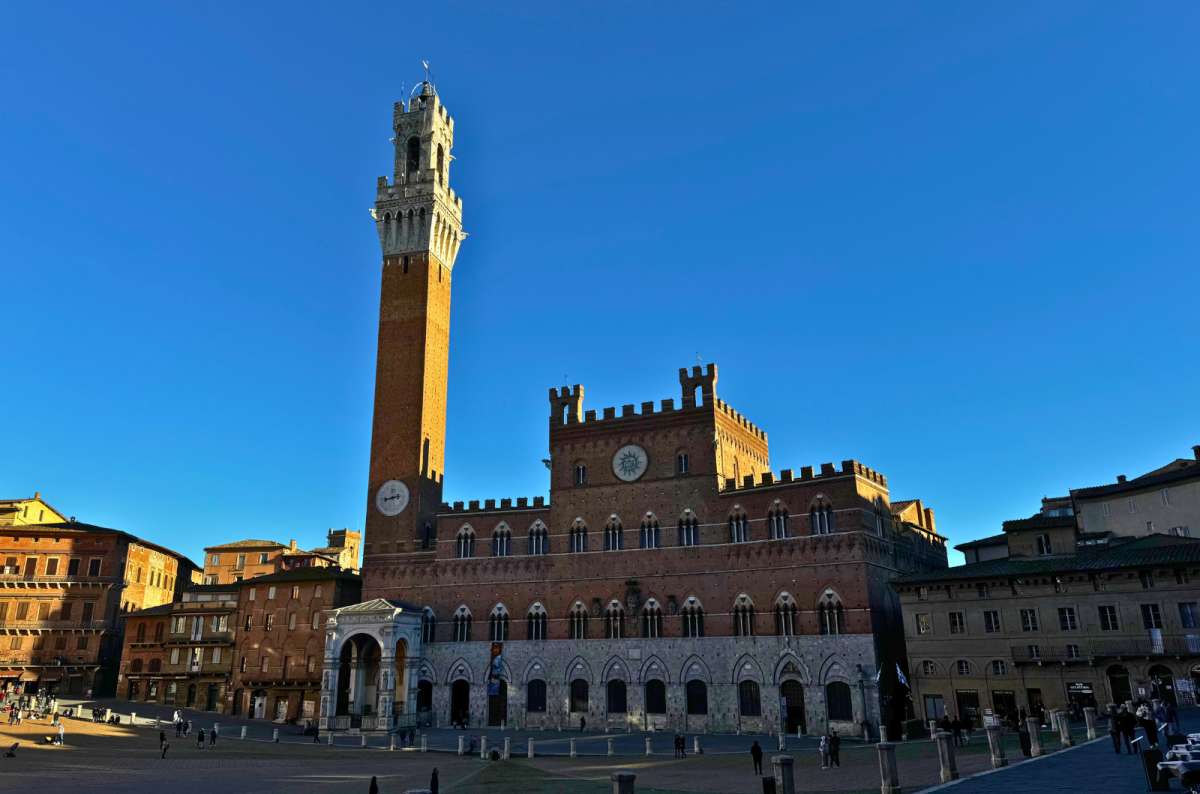
You’ll probably find Palazzo Pubblico on your own, but check out my itinerary at the end of this article for the perfect Siena day trip step-by-step instructions
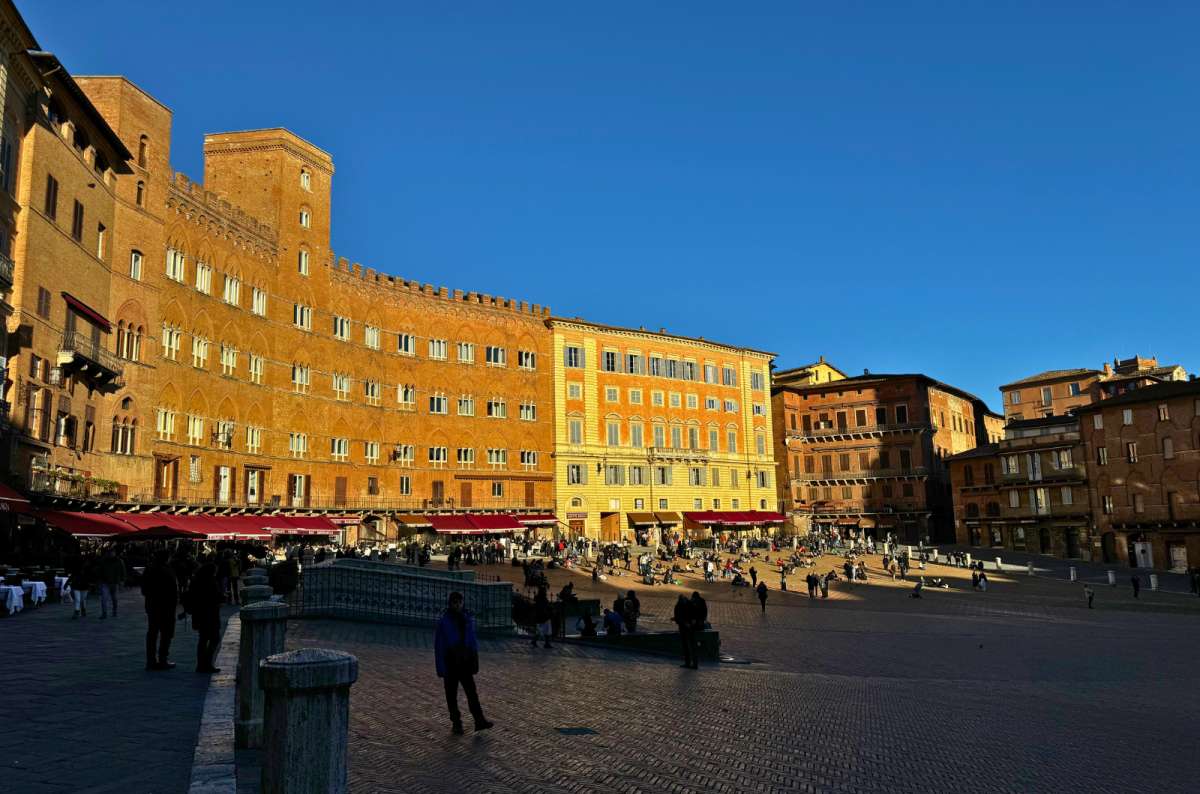
Continue reading this article, if you’re curious about what type of event takes place here every year (I guarantee you won’t guess it)
Visitor information (Palazzo Pubblico):
- Price: EUR 6
- Opening hours:
- 1 March–2 November 2025: 10 am–7pm
- 3 November–24 December 2025: 10:30 am–5:30 pm
- 26 December–6 January: 10 am–7 pm
This is the second must-see thing to do in Siena (after the Duomo complex). Piazza del Campo is Siena’s main square—shell-shaped, surprisingly sloped. People just sit on the ground, chilling, like it’s a beach or something. Or, you could just pay for a coffee and sit on a chair in a restaurant like an adult.
The Palazzo Pubblico (the town hall) is the clear eye-catcher on one side of the square, with its super tall tower called Torre del Mangia, clearly built to rival Venice’s. You’ve seen it from the cathedral viewpoints already. I didn’t climb it—the tickets are only sold on-site and go fast—but if you do, you know you’re getting some more impressive views of Siena.
There’s also the Fonte Gaia, a beautifully carved fountain worth a look, even if it’s just a replica.
Some call Piazza del Campo Italy’s most beautiful square. I’ll say it’s nice, but I’ve seen better.

9. Fortezza Medicea (fortress viewpoint): 30-minute visit
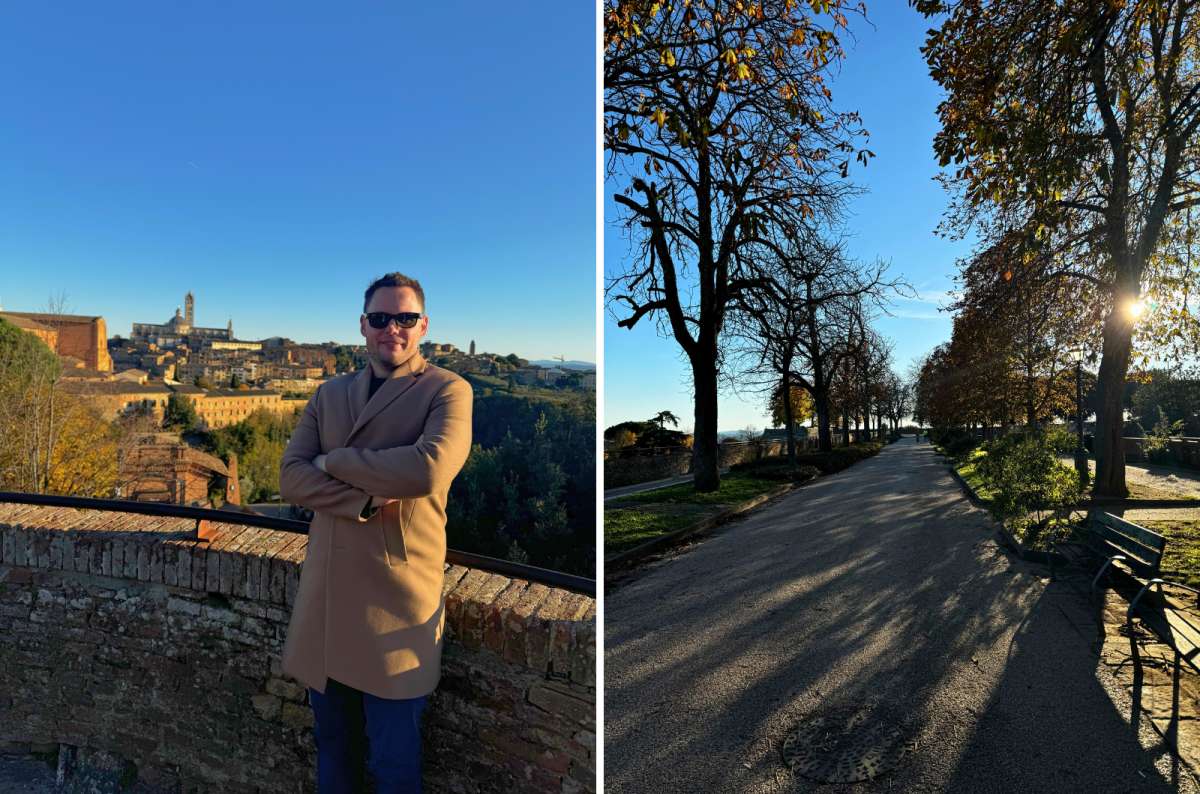
If there's something that Siena does very well, its panoramatic views
Visitor information:
- Price: free
- Opening hours: open 24/7
Fortezza Medicea is Siena’s old defensive fortress north of Old Town that’s now basically a public park with some of the best free views in Siena.
We walked along the walls in the afternoon before heading back to Florence and were honestly surprised how scenic it was—Siena sure is a beautiful city. From certain spots, you get a perfect panorama of the city and cathedral, especially if you catch it around sunset.
Inside the fortress is just a park with trees, playgrounds, and the occasional jogger. You can easily park right next to the walls at the parking lot.
If you're doing a Siena day trip from Florence, this is a great stop to decompress after the cathedral chaos.
10. Basilica Cateriniana San Domenico—the one with a saint’s head: 15-minute visit
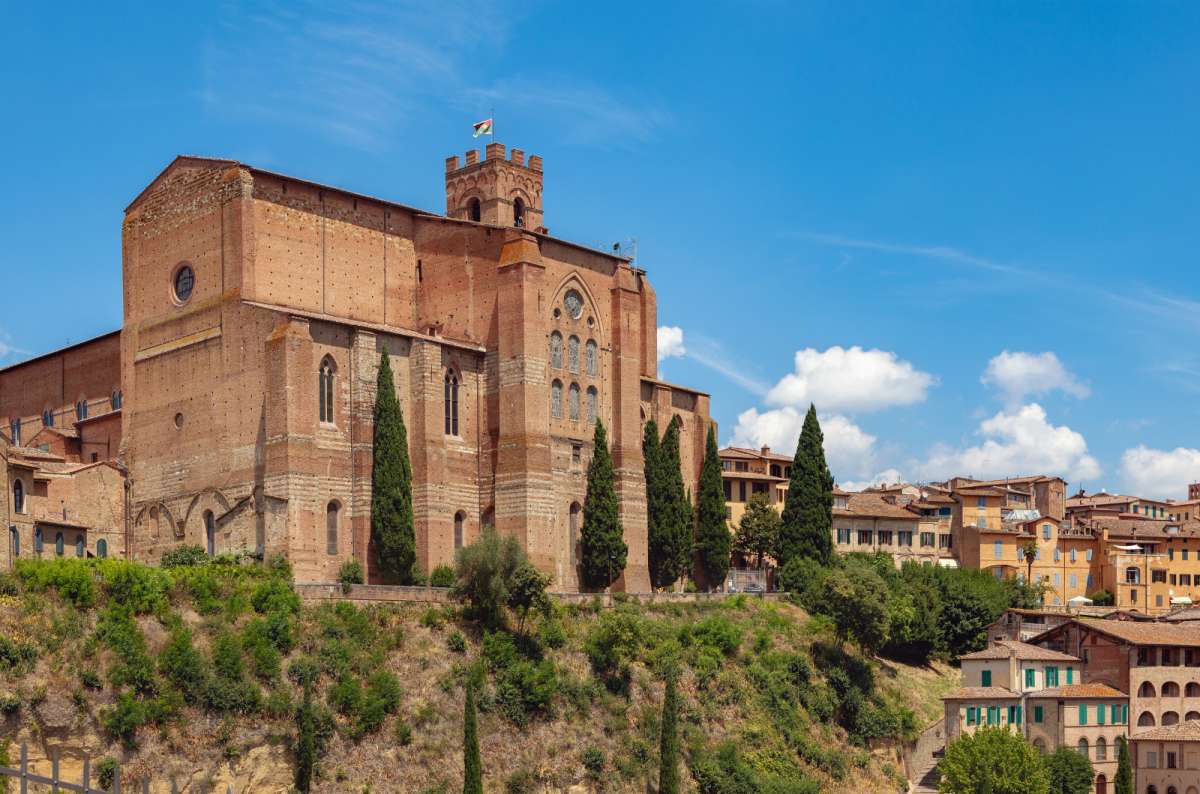
You really shouldn’t judge a book by its cover, though Basilica Cateriniana San Domenico may look unassuming, it hides something on the inside that will likely surprise you
Visitor information:
- Opening hours: Daily 8:45 am–5:45 pm
After the over-the-top Siena Cathedral, walking into Basilica Cateriniana San Domenico feels... bare. Inside and out, it’s all brick and minimal detail—like someone forgot to finish decorating. But stick with me—if you’re doing one a one day Siena itinerary, this stop adds depth to the whole experience.
But that’s the point. Well, that, and the fact that Saint Catherine of Siena’s actual head is kept here. And you can see it on display.
Here’s the backstory:
Saint Catherine of Siena was a 14th-century nun who became a big deal in the Catholic world. She was known for being political influencer—she even convinced the Pope to move back to Rome. After she died in Rome, people from Siena wanted to bring part of her back home. So, naturally, they took her head (and a thumb). End of story.
The basilica is massive and a little austere. When you enter, just follow your nose into a chapel dedicated to Saint Catherine and her mummified head (and thumb). Hey, it’s weird, but if you want to understand Siena’s obsession with its patron saint, this is the place to visit.
11. Sanctuary of Saint Catherine of Siena (Santuario Casa di Santa Caterina): 15-minute visit
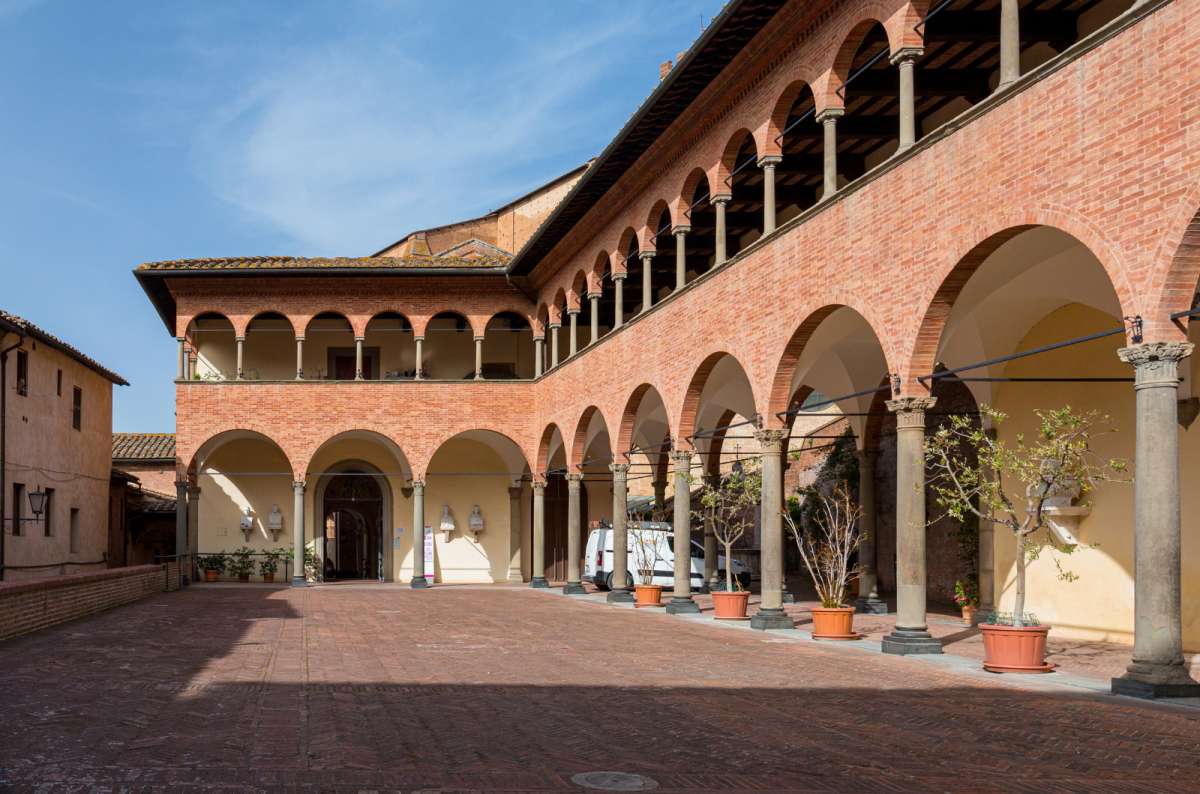
Some of the greatest people do not come from the greatest of circumstances @ Sanctuary of Saint Catherine of Siena
After the basilica, this next quick stop gives you a glimpse into the home life of Siena’s most famous saint… you know, before she moved to Rome, died, and her head came back to Siena to be displayed in the basilica.
The Sanctuary of Saint Catherine is built around what’s believed to be her family home. It’s just some modest chapels, quiet courtyards, and a few religious artworks, nothing dramatic.
It won’t take long to visit, but it does help tie the story together if you’ve just come from the basilica. Walking through her old home gives the whole saint-worship thing a bit more humanity.

12. Fontanina Contrada dell’Oca / Fontebranda: 15-minute visit
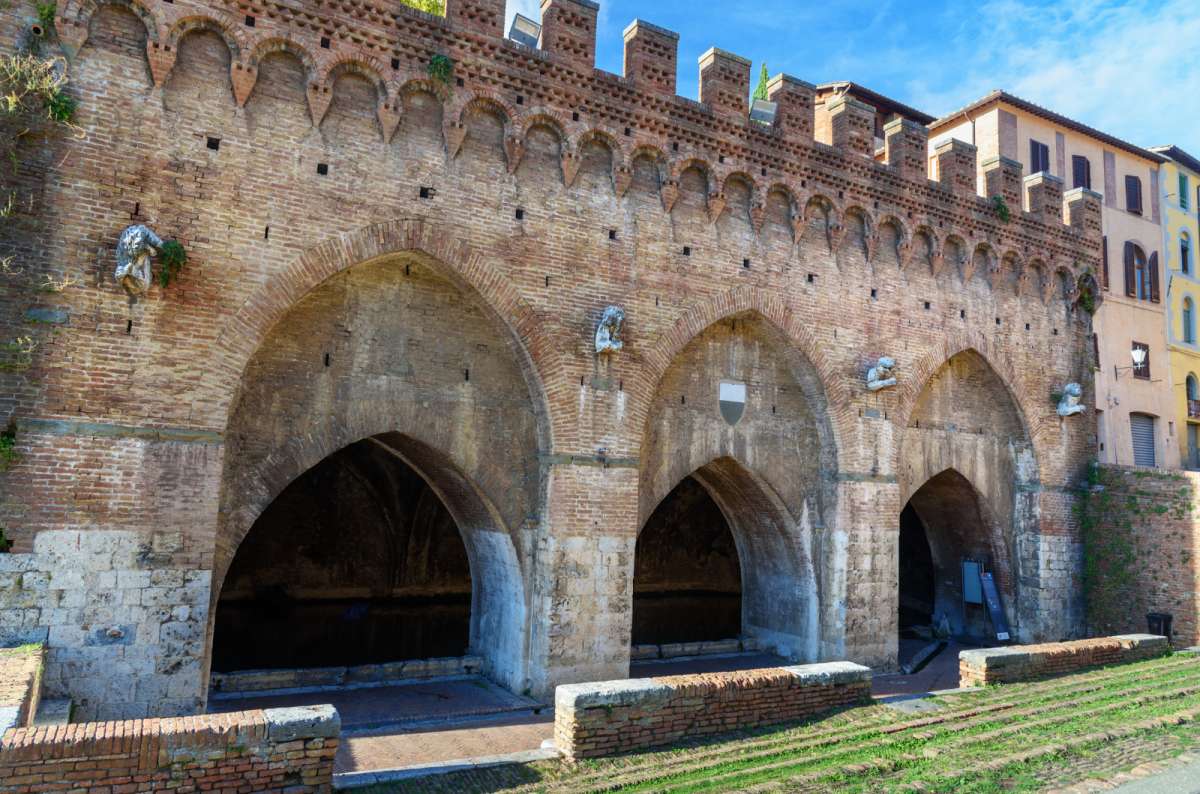
This is surely a great way to see how people used to live back in the old days without being surrounded by extreme crowds @ Fontebranda
Visitor information:
- Price: free
- Opening hours: open 24/7
Fontanina Contrada dell’Oca—also known as Fontebranda—is one of Siena’s oldest public fountains. Built in the 13thcentury, it’s fed by the same medieval aqueducts that still supply water to the city’s fountains.
Pro tip: The fountains are just downhill from the basilica and Saint Catherine’s sanctuary, so it works well to group these three spots together on your 1-day Siena itinerary.
It’s not a must-see in Siena like the Duomo or the main square, but it’s a rare slice of history. Worth 15 minutes in my book.
No tickets required.
13. Musei dell’Accademia dei Fisiocritici—Siena’s natural history museum: 45–60 min+

If nature exhibitions are your thing, then you have come to the right place @ Musei dell’Accademia dei Fisiocritici
Visitor information:
- Price: donations based
- Opening hours:
- April 1–October 31
- Monday to Friday: 9 am–4:30 pm
- Saturday: 2 pm–7 pm
- Sunday: 11 am–5:30 pm
- Closed on: April 20, July 1-2, August 15-16, 2025
- Special openings (11 am–6 pm): April 21, May 1, June 2, 2025
- November 1–March 31
- Monday to Friday: 9 am–3 pm
- Saturday: 1 pm–6 pm
- Sunday: Closed
- Closed on: December 8, December 17-26, 2025, January 1, January 6-11, 2026
- April 1–October 31
This place surprised me. Musei dell’Accademia dei Fisiocritici, Siena’s natural history museum feels more like an old-school archive than a modern museum—but it’s packed with stuff. Skeletons, fossils, taxidermy, minerals, jars with things floating inside, and even an underground part in an excavated section of the building. All that in a not very big building.
There’s a giant whale skeleton hanging overhead that kids were just staring at, mouths open. Honestly, same.
It’s based on donations—no official ticket price listed—and the staff were so friendly (not sure why I expected old and moldy ladies that wish you would leave quickly).
You’ll probably spend about an hour here. There’s not much signage in English, and some exhibits are cramped. But if you're looking for more things to do in Siena and need a break from churches, this museum is the exact kind of unique stop that makes a trip memorable. Especially with kids in tow.
14. National Picture Gallery of Siena: 45-minute visit
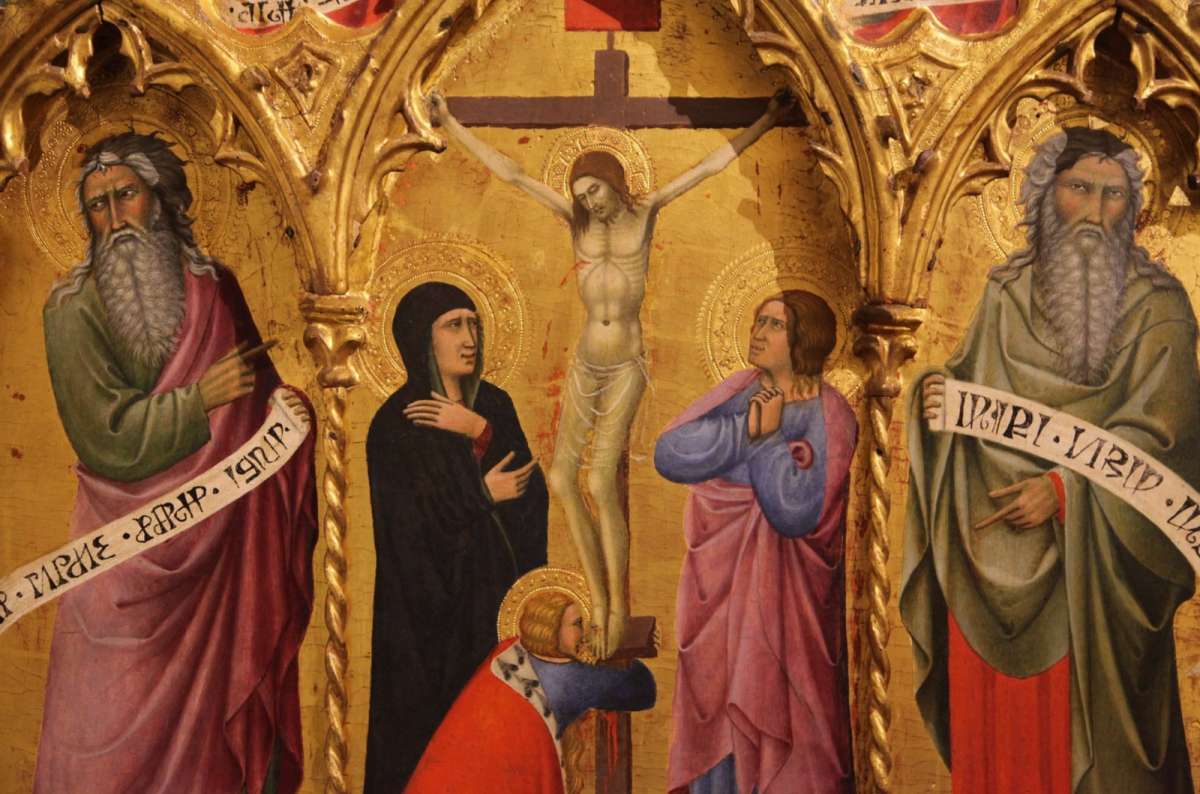
A skillful collection of uniquely concerned faces @ National Picture Gallery of Siena
Visitor information:
- Price: EUR 8
- Opening hours:
- Monday, Friday, Saturday, Sunday (1st, 3rd and 5th of the month) and midweek holidays 8:30am–1:30 pm
- Tuesday Wednesday and Thursday 2 pm–7 pm (the ticket office closes half an hour earlier)
- Closed: 2nd and 4th Sunday of the month; January 1st and December 25th.
Full disclosure: I didn’t go. After Florence, my brain simply couldn’t handle another gallery.
That said, the National Picture Gallery of Siena (Pinacoteca Nazionale di Siena) is considered one of Italy’s most important museums for medieval and early Renaissance painting. If names like Duccio, Simone Martini, and the Lorenzetti brothers mean something to you, make sure to keep some capacity for gallery visits so you can squeeze it into your day in Siena.
The museum is located in a couple of old palaces and focuses on the Sienese School—that means tempera on wood, lots of altarpieces, and faces that all look vaguely worried.
If you’re a casual traveler doing a Siena day trip from Florence, you might want to skip it. But if you're into religious art or want to dive deeper into Siena’s artistic identity, this pinacoteca’s a solid choice.

15. Bonus stop near Siena: San Gimignano, the tower town (2–3 hours)
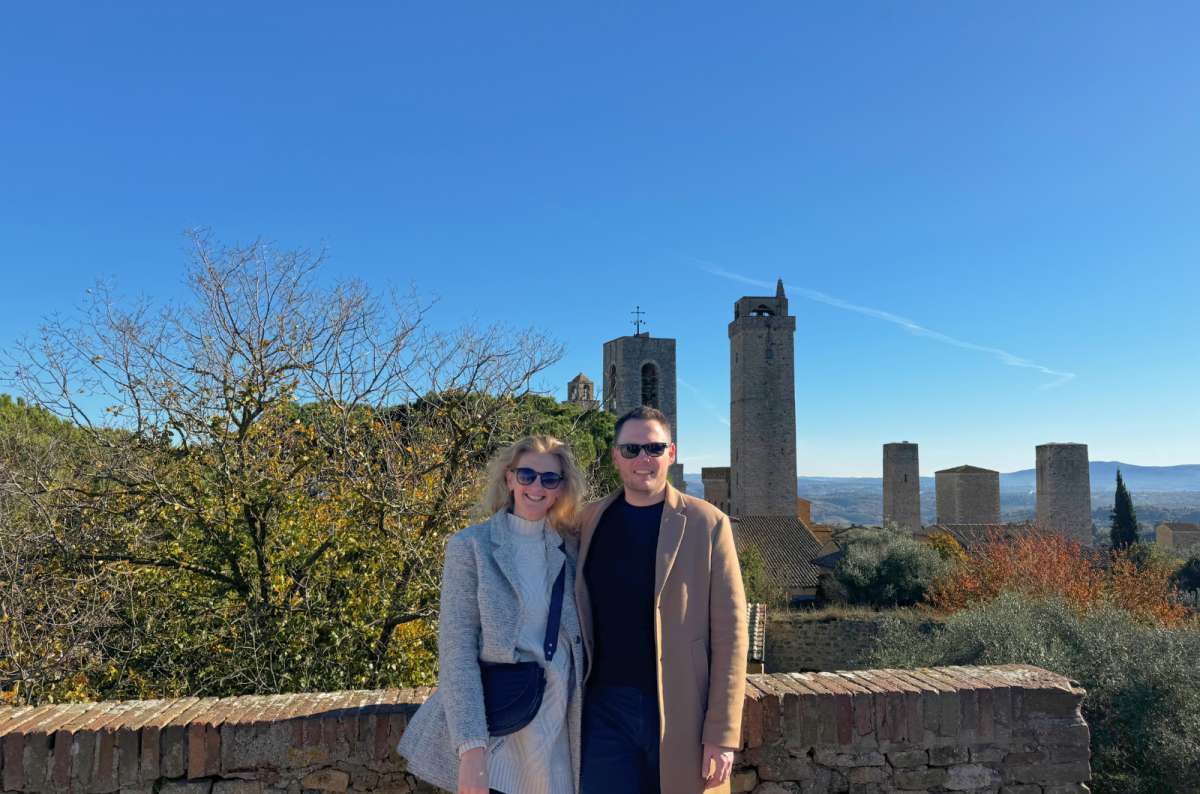
If you pick the right weather, San Gimignano turns into the perfect fairytale spot, filled with bright colours
Visitor information:
- Price: EUR 9
- Opening hours:
- April 1–October 31: daily from 10 am to 7:30 pm
- November 1–March 31: open daily from 11 am to 5:30 pm
Finally, let’s about San Gimignano, a hilltop town stuffed with towers. You’ve probably seen photos of it before even knowing what it was. It’s often sold as a must-see in Tuscany, but I think it’s overhyped. It’s similar to Siena, but Siena is endlessly more picturesque.
Still, if you’re on a Siena day trip from Florence, it makes a decent side quest; just make sure to stop in San Gimignano first and do Siena second to avoid complete disappointment.
Parking is around EUR 2.50/hour, and you can see the main sights in about 2 hours. Three if you are super into it and dawdle.
The highlight here is Torre Grossa, a 54-meter (177-foot) tower that you can climb for some of the best views in Tuscany. Everyone talks about the iconic Tuscan hills—well, you really feel them here. It’s easily one of the prettiest tower views in Italy.
Oddly though, from the top, you don’t see much of San Gimignano’s own towers.
Entry is EUR 9, which includes the Civic Museum (Musei Civici), the tiny Duomo, and the Museum of Sacred Art.
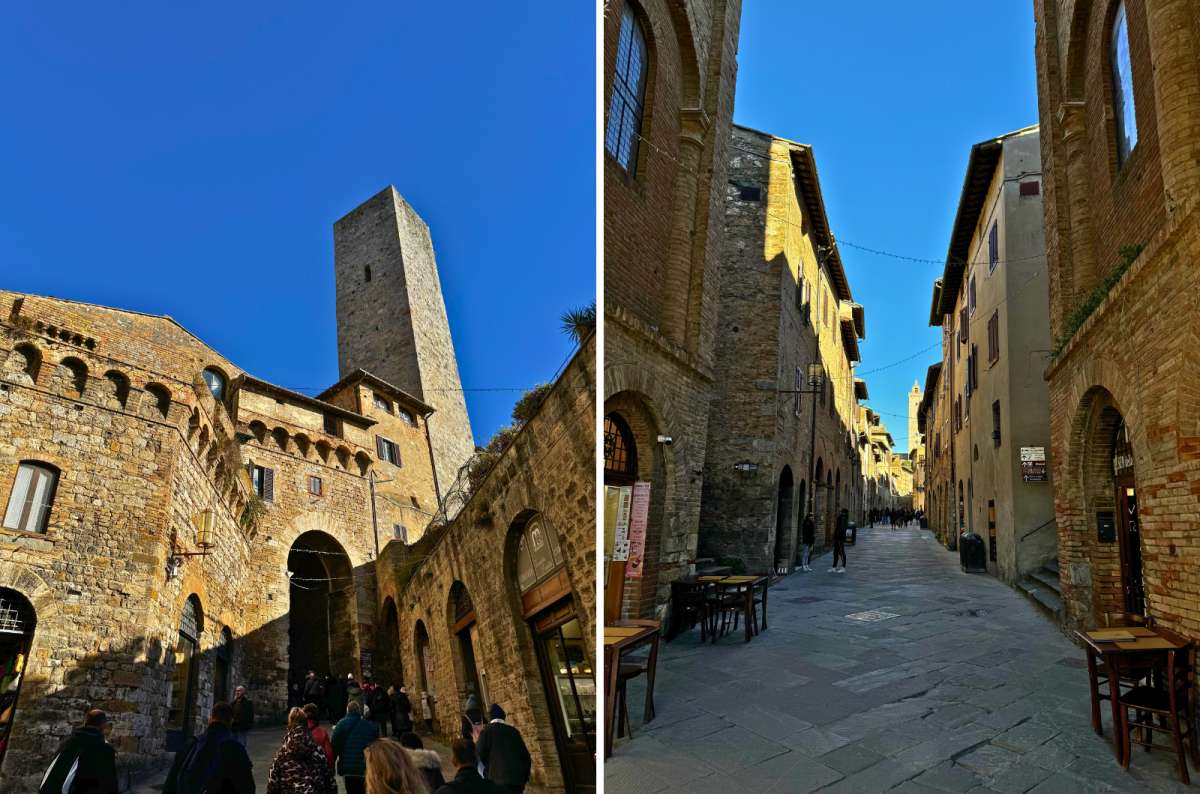
The streets of San Gimignano sure are absolutely delightful
Other good stops in San Gimignano:
- Piazza della Cisterna—the main square
- San Gimignano 1300—a miniature model of the town
- Porta San Giovanni to Porta San Matteo—the best 15-minute walk across town
- Parco della Rocca—best views of the towers
- Don’t forget about truffle season! Everything’s covered in or smelling of truffles if you visit in the fall.
There’s even a mini trail nearby, Sentiero d’Elsa, for a quick nature fix before you head to or from Siena.
Would I go again? Probably not. But if you’ve got time and want to see Tuscany’s version of a medieval skyscraper district, it’s worth a quick walk-through.

One day in Siena itinerary: Step by step
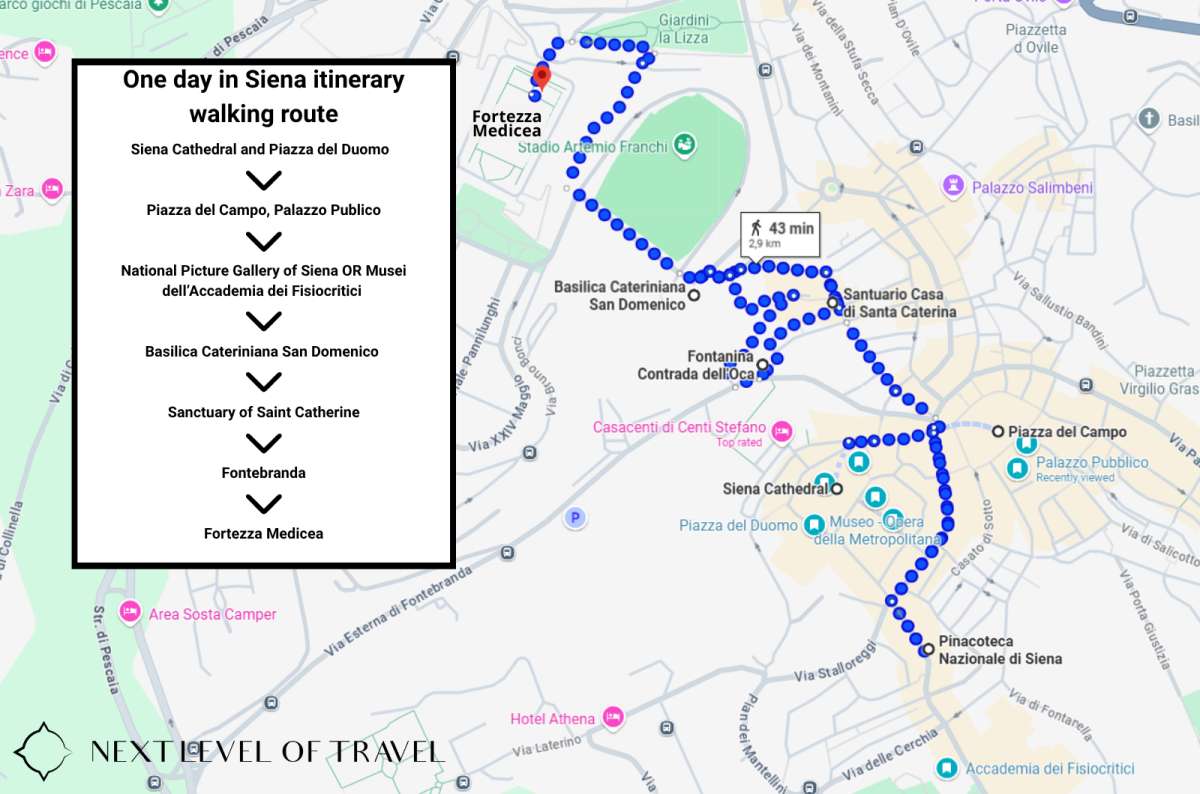
Map of your itinerary: Start at the Cathedral and end your day trip to Siena at Fortezza Medicea for views over the city
Here’s how to spend a day in Siena (remember to stop by San Gimignano first if coming on a day trip from Florence):
Stop 1: Start at the Duomo Complex
Begin your day in Siena at its most important site. Visit the Cathedral, Picolomini Library, Crypt, Baptistery, Museo dell’Opera, Facciatone panorama, and Porta del Cielo (if included in your ticket). 2–3 hours.
Stop 2: Walk through Piazza del Campo
Head downhill to Siena’s main square. Take in the unique shape, see the Fonte Gaia fountain, and admire the Palazzo Pubblico with its tall medieval tower (Torre del Mangia). 20 minutes.
Stop 3: Choose one museum
Depending on your interest (1 hour):
- Go to the Natural History Museum for something quirky, dense, and off the usual tourist trail
- Or the National Picture Gallery if you’re into Sienese religious art and early Renaissance panels
Stop 4: Visit Basilica San Domenico and the Sanctuary of Saint Catherine
From the Campo, walk northwest to these two sites—they’re right next to each other. The basilica is where you’ll find Saint Catherine’s relics, and the sanctuary is built on the site of her family home. 30 minutes.
Stop 5: Optional detour to Fontebranda
Just a few minutes downhill from the basilica, this medieval fountain is still fed by Siena’s ancient aqueduct system. A quiet, historical stop with no crowds and no ticket. 15 minutes.
Stop 6: End at Fortezza Medicea
Finish your day at this relaxed fortress park with panoramic views. Great spot for sunset or just to sit down and breathe after a full day in Siena. (30 minutes)
(Reminder: my hotel tip for Siena is Hotel Certosa Di Maggiano. In case you want to wine and dine and not drive in the evening.)
Visiting in summer? Experience Siena’s famous event: The Palio di Siena
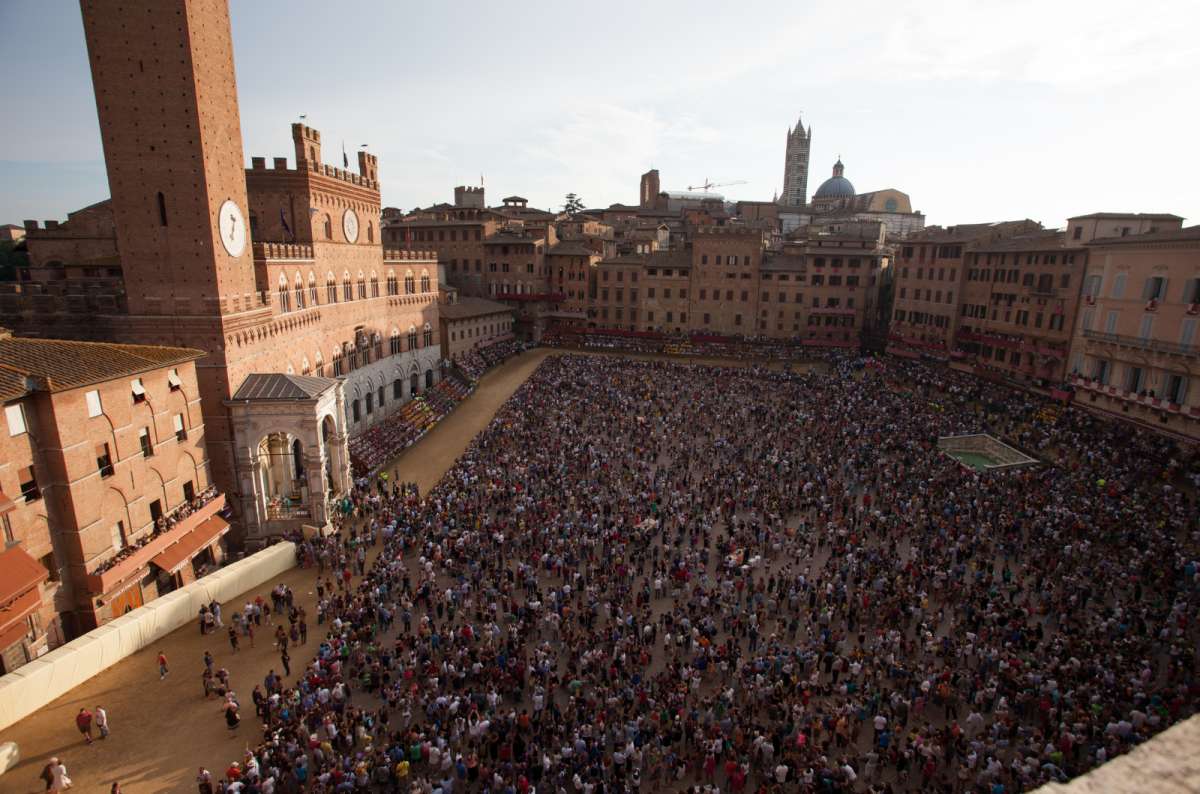
All cultures and cities have their little something, I find this to be one of the more “unique” somethings
If you're lucky (or unlucky) enough to visit on July 2 or August 16, you'll be there for the Palio di Siena—a horse race around Piazza del Campo. Be warned that the drama starts days ahead of the race, especially when horse are being assigned to the 17 rivaling neighborhoods by lottery. I imagine it’s hilarious, because they could train all year and end up with a dud horse.
Jockeys ride bareback for neighborhood glory while a packed square screams like it’s a World Cup final.
Tickets for balconies and grandstands are expensive (hundreds of euros expensive) and sell out early. Standing in the middle is free—but once you're in, you're stuck for hours with no shade or bathrooms.
I personally have no desire to see this crazy horse race—I hate crowds and am allergic to horses, but I can imagine it’s a, um, memorable experience.
Planning your visit: How to get to Siena
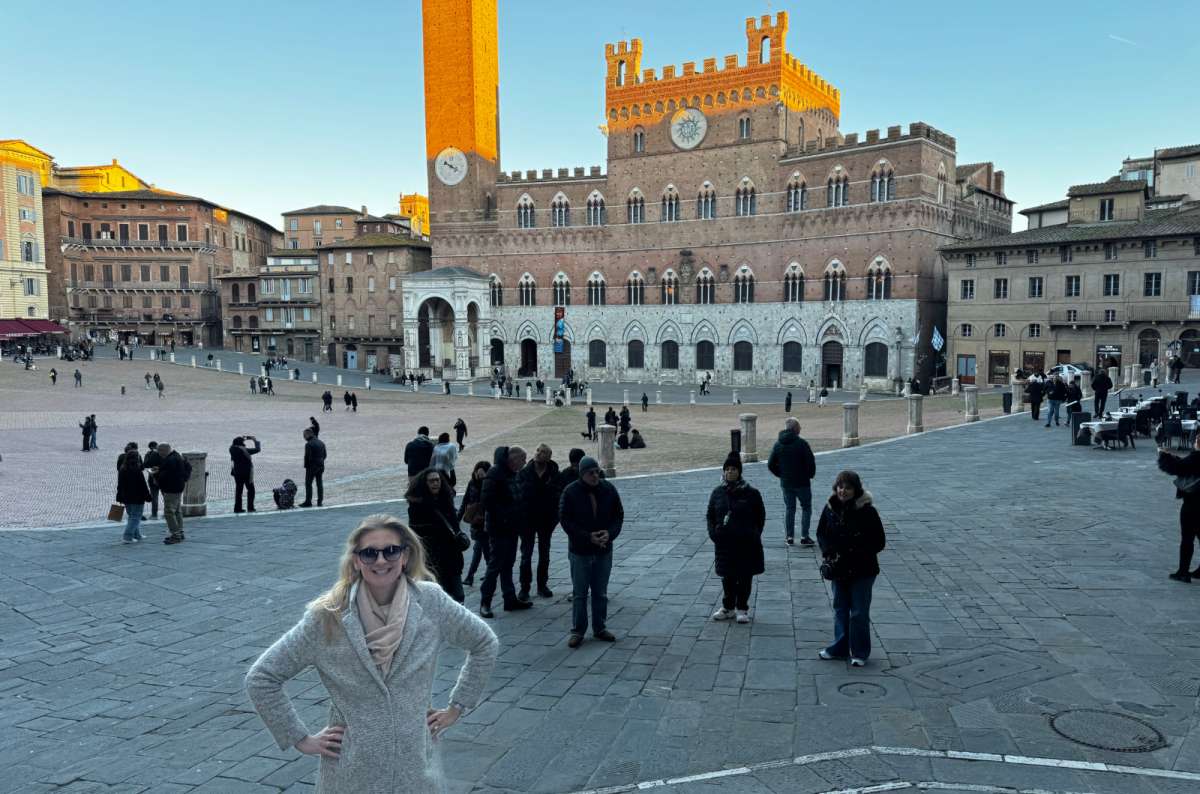
The trip is easy to make, so why not take a day out of your Florence itinerary and visit the lovely Piazza dei Campo in Siena?
If you’re doing a Siena day trip from Florence, you’ve got two solid options: drive or train. I always rent a car, and this was no exception.
By Car:
-
Florence to Siena: 1 hr 15 min via the Raccordo Autostradale.
-
Perfect if you want to stop in San Gimignano on the way—add about 30 minutes for the detour drive.
-
Parking in Siena is easy: expect to pay around EUR 2/hour at one of the parking garages near the historic center (try Il Campo or Santa Caterina)—just follow signs to “Parcheggio.”
By Train:
-
Florence to Siena: 1.5 hours. Trains run about once an hour.
-
Tickets cost EUR 10–12 one way.
-
The station is about 15–20 minutes uphill on foot to Siena’s historic center.
Where to next?
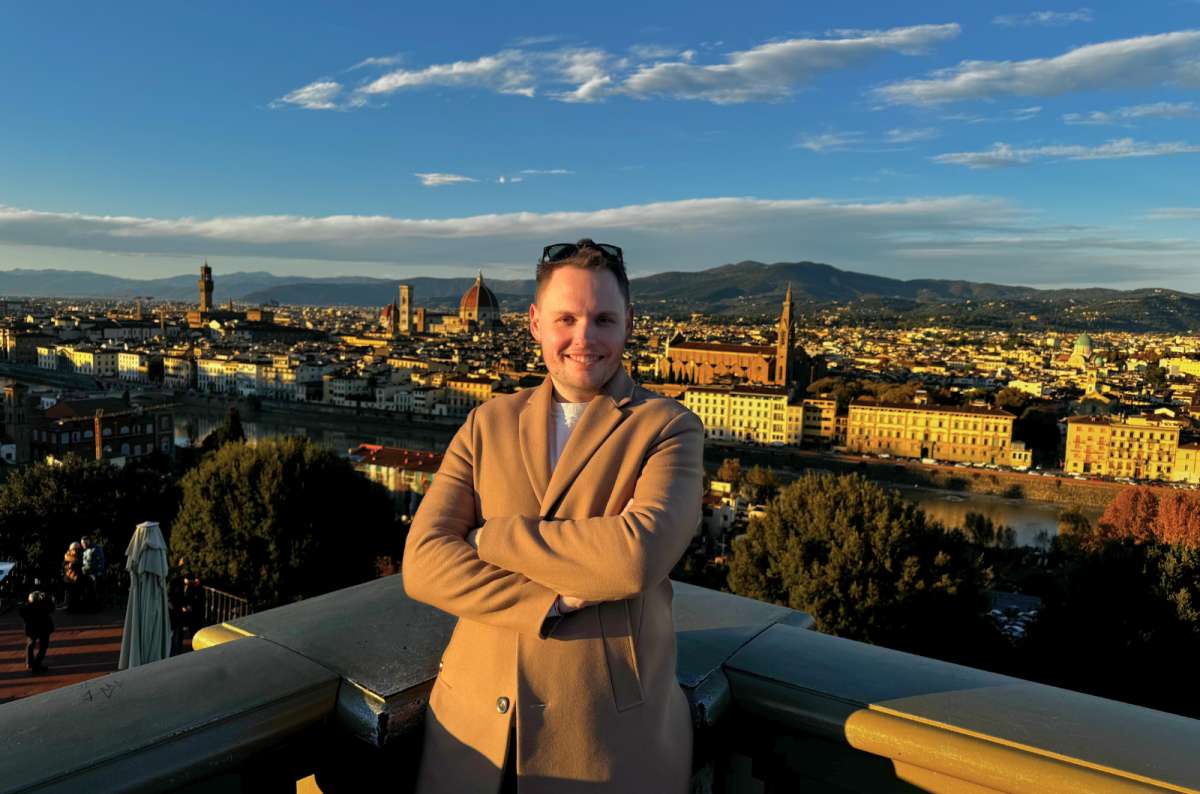
If Siena wasn’t enough for you, prepare for gallery overload in beautiful Florence
If Siena isn’t your only stop in Tuscany, here’s where to head next (or before):
- Florence—Gallery overload, excellent food, and the reason you’re probably in Tuscany to begin with. Read my brutally honest Florence guide + 3-day Florence itinerary
- Lucca—Quieter, walled, and weirdly underrated. I loved it. Here’s my review on why Lucca deserves a visit
- Pisa—Come for the Leaning Tower, stay for Piazza dei Miracoli. I was blown away! What to actually do in Pisa for a day
Sometimes, all you need to do is take the first step... I've filtered out the best hotels in Siena for you
Save it for yourself to come back to later, or share with your friends on social media!
This post contains affiliate links. If you make a booking through one of my links, I may earn a small commission—at no additional cost to you. Thank you for your support!
What you’ll find in this article
Map of what to see in Siena, Italy
Quick list: 15 best places to visit and what to do in Siena in a day
1. The Siena Cathedral Complex and Piazza del Duomo: 2–3 hours total
2. Facciatone Panorama (enter through cathedral museum): 30-minute visit
3. Museo dell’Opera (part of cathedral combo): 30-minute visit
4. Crypt (inside the cathedral): 10-minute visit
5. Baptistery of San Giovanni (inside the cathedral): 15-minute visit
6. Picolomini Library (inside the cathedral): 5-minute visit
7. Porta del Cielo aka “Gate of Heaven” (inside the cathedral): 25-minute visit
8. Siena’s main square, Piazza del Campo, and Palazzo Publico, the town hall: 15-minute visit
9. Fortezza Medicea (fortress viewpoint): 30-minute visit
10. Basilica Cateriniana San Domenico—the one with a saint’s head: 15-minute visit
11. Sanctuary of Saint Catherine of Siena (Santuario Casa di Santa Caterina): 15-minute visit
12. Fontanina Contrada dell’Oca / Fontebranda: 15-minute visit
13. Musei dell’Accademia dei Fisiocritici—Siena’s natural history museum: 45–60 min+
14. National Picture Gallery of Siena: 45-minute visit
15. Bonus stop near Siena: San Gimignano, the tower town (2–3 hours)
One day in Siena itinerary: Step by step
Visiting in summer? Experience Siena’s famous event: The Palio di Siena




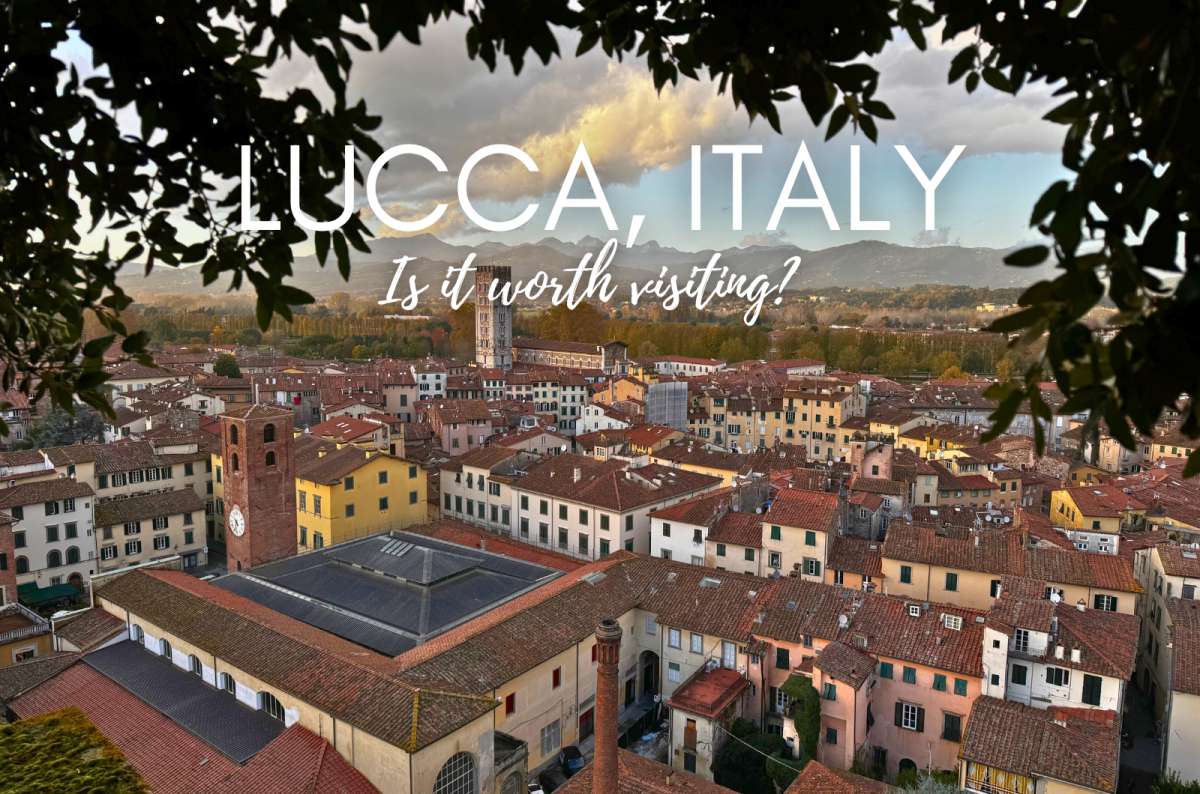
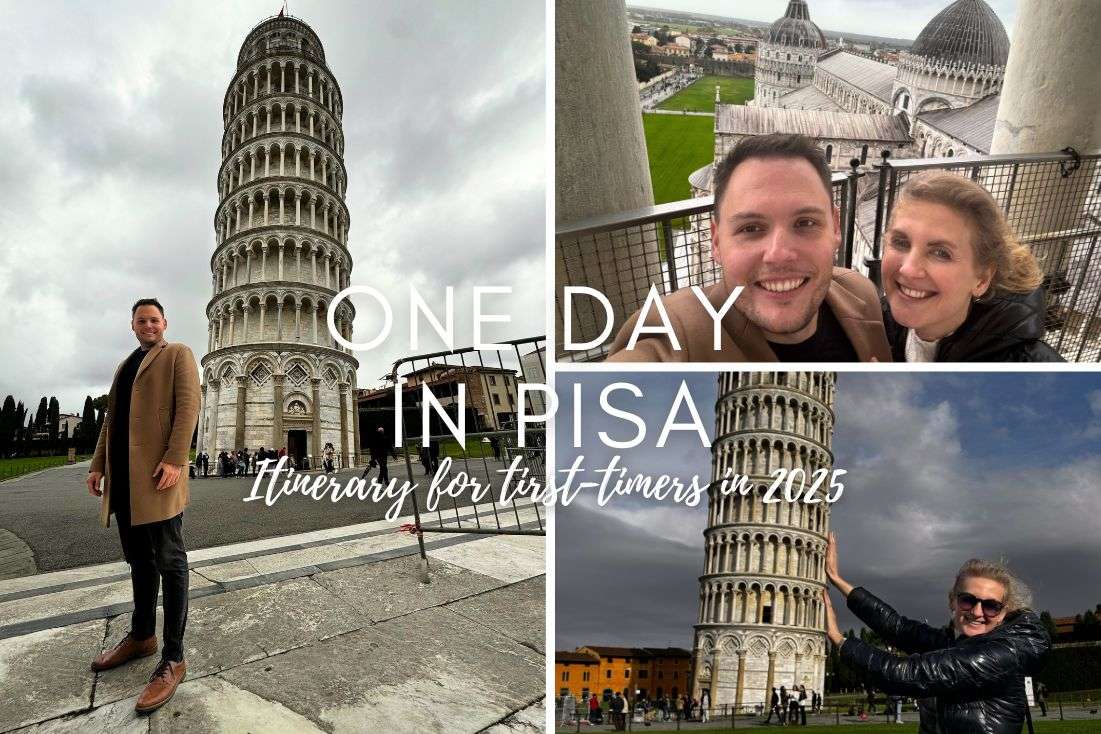




Comments | Thoughts? Give us a shout!